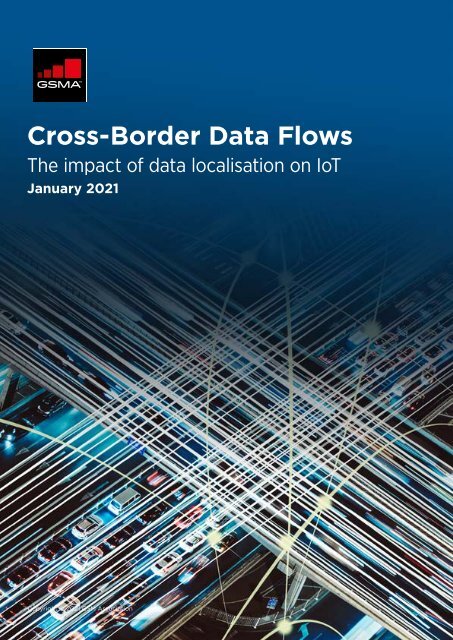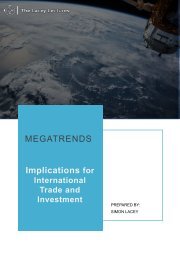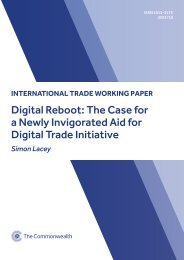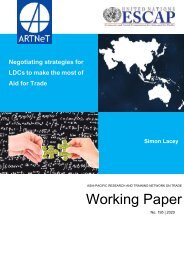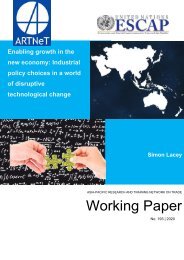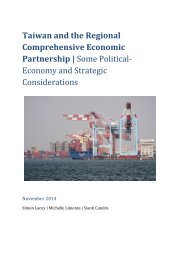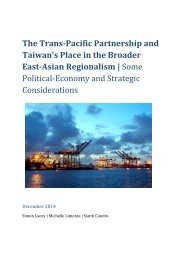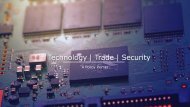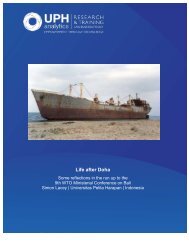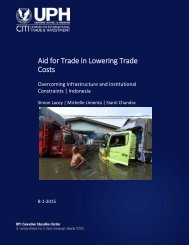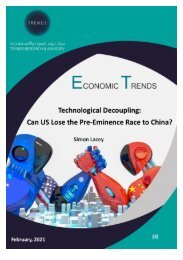Cross Border Data Flows: The impact of data localisation on IoT
This industry report seeks to shed new light on the costs of imposing data localization requirements or other restrictions on cross-border data flows with respect to the important economic growth likely to result from the uptake and adoption of IoT in manufacturing, agriculture and other important sectors of the economy. It chooses 3 large emerging markets in order to showcase its model, namely Brazil, Indonesia and South Africa.
This industry report seeks to shed new light on the costs of imposing data localization requirements or other restrictions on cross-border data flows with respect to the important economic growth likely to result from the uptake and adoption of IoT in manufacturing, agriculture and other important sectors of the economy. It chooses 3 large emerging markets in order to showcase its model, namely Brazil, Indonesia and South Africa.
You also want an ePaper? Increase the reach of your titles
YUMPU automatically turns print PDFs into web optimized ePapers that Google loves.
<str<strong>on</strong>g>Cross</str<strong>on</strong>g>-<str<strong>on</strong>g>Border</str<strong>on</strong>g> <str<strong>on</strong>g>Data</str<strong>on</strong>g> <str<strong>on</strong>g>Flows</str<strong>on</strong>g><br />
<str<strong>on</strong>g>The</str<strong>on</strong>g> <str<strong>on</strong>g>impact</str<strong>on</strong>g> <str<strong>on</strong>g>of</str<strong>on</strong>g> <str<strong>on</strong>g>data</str<strong>on</strong>g> <str<strong>on</strong>g>localisati<strong>on</strong></str<strong>on</strong>g> <strong>on</strong> <strong>IoT</strong><br />
January 2021<br />
Copyright © 2021 GSM Associati<strong>on</strong>
About the GSMA<br />
<str<strong>on</strong>g>The</str<strong>on</strong>g> GSMA represents the interests <str<strong>on</strong>g>of</str<strong>on</strong>g> mobile<br />
operators worldwide, uniting more than 750 operators<br />
and nearly 400 companies in the broader mobile<br />
ecosystem, including handset and device makers,<br />
s<str<strong>on</strong>g>of</str<strong>on</strong>g>tware companies, equipment providers and internet<br />
companies, as well as organisati<strong>on</strong>s in adjacent industry<br />
sectors. <str<strong>on</strong>g>The</str<strong>on</strong>g> GSMA also produces the industry-leading<br />
MWC events held annually in Barcel<strong>on</strong>a, Los Angeles and<br />
Shanghai, as well as the Mobile 360 Series <str<strong>on</strong>g>of</str<strong>on</strong>g> regi<strong>on</strong>al<br />
c<strong>on</strong>ferences.<br />
For more informati<strong>on</strong>, please visit the GSMA corporate<br />
website at www.gsma.com and public<br />
policy website at www.gsma.com/publicpolicy<br />
Follow the GSMA <strong>on</strong> Twitter: @GSMA and @GSMAPolicy<br />
Authors<br />
Hosuk Lee-Makiyama, Badri Narayanan - ECIPE<br />
Sim<strong>on</strong> Lacey - University <str<strong>on</strong>g>of</str<strong>on</strong>g> Adelaide
C<strong>on</strong>tents<br />
Abstract<br />
Policy Report<br />
Technical Report<br />
How the scenarios are defined?<br />
Exploring the results<br />
C<strong>on</strong>clusi<strong>on</strong>: what does the <str<strong>on</strong>g>data</str<strong>on</strong>g> tell us?<br />
3<br />
4<br />
8<br />
12<br />
16<br />
24<br />
1
CROSS-BORDER DATA FLOWS: THE IMPACT OF DATA LOCALISATION ON IOT<br />
<str<strong>on</strong>g>The</str<strong>on</strong>g> Internet <str<strong>on</strong>g>of</str<strong>on</strong>g> Things (<strong>IoT</strong>) is hugely important and rapidly<br />
growing, with the potential to transform the digital ec<strong>on</strong>omy.<br />
Its industrial use is already having a significant <str<strong>on</strong>g>impact</str<strong>on</strong>g> <strong>on</strong> how<br />
businesses operate, and the widespread use <str<strong>on</strong>g>of</str<strong>on</strong>g> 5G will <strong>on</strong>ly further<br />
accelerate this transformati<strong>on</strong>. With <strong>IoT</strong> c<strong>on</strong>necti<strong>on</strong>s currently<br />
growing by almost 15 per cent annually, by 2025 this is set to reach<br />
approximately 25 billi<strong>on</strong> - vastly outnumbering pers<strong>on</strong>al devices<br />
(such as ph<strong>on</strong>es and computers) c<strong>on</strong>nected to wireless networks.<br />
Acknowledging the transformative steps that IOT can have <strong>on</strong><br />
ec<strong>on</strong>omic growth, GSMA’s latest study explores how the adopti<strong>on</strong><br />
<str<strong>on</strong>g>of</str<strong>on</strong>g> <str<strong>on</strong>g>Data</str<strong>on</strong>g> Localisati<strong>on</strong> Requirements (DLRs) could negatively <str<strong>on</strong>g>impact</str<strong>on</strong>g><br />
the many gains generated to date. In does so for three emerging<br />
countries: Brazil; Ind<strong>on</strong>esia; and South Africa.<br />
Whilst the study is hypothetical, it findings do allow us to<br />
c<strong>on</strong>sider the negative c<strong>on</strong>sequences <str<strong>on</strong>g>of</str<strong>on</strong>g> imposing DLRs and similar<br />
restricti<strong>on</strong>s <strong>on</strong> cross-border <str<strong>on</strong>g>data</str<strong>on</strong>g> flows and how to mitigate the<br />
<str<strong>on</strong>g>impact</str<strong>on</strong>g> <str<strong>on</strong>g>of</str<strong>on</strong>g> these measures. Acknowledging that the viability and<br />
<str<strong>on</strong>g>impact</str<strong>on</strong>g> <str<strong>on</strong>g>of</str<strong>on</strong>g> <strong>IoT</strong> is c<strong>on</strong>tingent <strong>on</strong> governments adopting a positive<br />
regulatory framework, the study c<strong>on</strong>cludes by outlining a number<br />
<str<strong>on</strong>g>of</str<strong>on</strong>g> acti<strong>on</strong>s to support growth in this sector and minimise trade<br />
restricti<strong>on</strong>s.<br />
2
CROSS-BORDER DATA FLOWS: THE IMPACT OF DATA LOCALISATION ON IOT<br />
Abstract<br />
<str<strong>on</strong>g>The</str<strong>on</strong>g> Internet <str<strong>on</strong>g>of</str<strong>on</strong>g> Things (<strong>IoT</strong>) will have far-reaching and beneficial effects for both advanced<br />
industrialised ec<strong>on</strong>omies and emerging ec<strong>on</strong>omies.<br />
• <str<strong>on</strong>g>The</str<strong>on</strong>g> number <str<strong>on</strong>g>of</str<strong>on</strong>g> <strong>IoT</strong> c<strong>on</strong>necti<strong>on</strong>s is growing by almost 15% per year and is set to reach approximately 25<br />
billi<strong>on</strong> c<strong>on</strong>necti<strong>on</strong>s by 2025. <str<strong>on</strong>g>The</str<strong>on</strong>g> sectors that are heavily <str<strong>on</strong>g>impact</str<strong>on</strong>g>ed by <strong>IoT</strong> play a crucial role in emerging<br />
ec<strong>on</strong>omies such as agriculture, basic manufacturing, transport, logistics, healthcare and educati<strong>on</strong>.<br />
Bey<strong>on</strong>d simple productivity gains, adopting <strong>IoT</strong> will produce significant dynamic effects<br />
across the entire ec<strong>on</strong>omy.<br />
• <strong>IoT</strong> has already become a horiz<strong>on</strong>tal technology with an <str<strong>on</strong>g>impact</str<strong>on</strong>g> across many sectors, including<br />
manufacturing, agriculture, mining, retail, transport, utilities, healthcare, entertainment and educati<strong>on</strong>.<br />
• As the distincti<strong>on</strong> between ‘the ec<strong>on</strong>omy’ and ‘the digital ec<strong>on</strong>omy’ fades we see the uptake <str<strong>on</strong>g>of</str<strong>on</strong>g> <strong>IoT</strong> and related<br />
technologies having a transformative <str<strong>on</strong>g>impact</str<strong>on</strong>g> <strong>on</strong> the way people live and how firms do business, meaning that<br />
<strong>IoT</strong> gains start to produce first and sec<strong>on</strong>d order ec<strong>on</strong>omic effects across the whole ec<strong>on</strong>omy.<br />
<str<strong>on</strong>g>Data</str<strong>on</strong>g> Localisati<strong>on</strong> Requirements (DLRs), however, will have a significant negative <str<strong>on</strong>g>impact</str<strong>on</strong>g><br />
and undermine many <str<strong>on</strong>g>of</str<strong>on</strong>g> the <strong>IoT</strong> gains to Gross Domestic Product (GDP) growth, employment,<br />
trade and investment.<br />
• This study uses the well-recognised GTAP methodology to estimate the negative <str<strong>on</strong>g>impact</str<strong>on</strong>g> that DLRs and other<br />
restricti<strong>on</strong>s <strong>on</strong> cross-border <str<strong>on</strong>g>data</str<strong>on</strong>g> flows have <strong>on</strong> the gains generated by <strong>IoT</strong> deployment in three emerging<br />
countries: Brazil; Ind<strong>on</strong>esia; and South Africa.<br />
• It is evident that the cost <str<strong>on</strong>g>of</str<strong>on</strong>g> imposing DLRs and similar restricti<strong>on</strong>s <strong>on</strong> cross-border <str<strong>on</strong>g>data</str<strong>on</strong>g> flows will <strong>on</strong>ly<br />
increase in future, owing to the growing importance <str<strong>on</strong>g>of</str<strong>on</strong>g> <str<strong>on</strong>g>data</str<strong>on</strong>g> in all areas <str<strong>on</strong>g>of</str<strong>on</strong>g> ec<strong>on</strong>omic activity. <str<strong>on</strong>g>The</str<strong>on</strong>g> model<br />
takes into account any positive <str<strong>on</strong>g>impact</str<strong>on</strong>g>s <str<strong>on</strong>g>of</str<strong>on</strong>g> <str<strong>on</strong>g>data</str<strong>on</strong>g> <str<strong>on</strong>g>localisati<strong>on</strong></str<strong>on</strong>g> when foreign suppliers are replaced by domestic<br />
competitors due to <str<strong>on</strong>g>data</str<strong>on</strong>g> <str<strong>on</strong>g>localisati<strong>on</strong></str<strong>on</strong>g> requirements.<br />
<str<strong>on</strong>g>The</str<strong>on</strong>g> model estimates that DLRs and other restricti<strong>on</strong>s <strong>on</strong> cross-border <str<strong>on</strong>g>data</str<strong>on</strong>g> flows will wipe<br />
out over half <str<strong>on</strong>g>of</str<strong>on</strong>g> the potential gains countries stand to make by adopting <strong>IoT</strong>.<br />
• <str<strong>on</strong>g>Data</str<strong>on</strong>g> <str<strong>on</strong>g>localisati<strong>on</strong></str<strong>on</strong>g> more than halves the GDP gains <str<strong>on</strong>g>of</str<strong>on</strong>g> adopting <strong>IoT</strong> – by: 59% in Brazil; 61% in Ind<strong>on</strong>esia; and<br />
68% in South Africa.<br />
• <str<strong>on</strong>g>Data</str<strong>on</strong>g> <str<strong>on</strong>g>localisati<strong>on</strong></str<strong>on</strong>g> also has a c<strong>on</strong>siderable negative <str<strong>on</strong>g>impact</str<strong>on</strong>g> <strong>on</strong> employment, causing job losses <str<strong>on</strong>g>of</str<strong>on</strong>g> around:<br />
205,000 in Brazil; 372,000 in Ind<strong>on</strong>esia; and 182,000 in South Africa.<br />
3
CROSS-BORDER DATA FLOWS: THE IMPACT OF DATA LOCALISATION ON IOT<br />
Policy Report<br />
Background<br />
Investigating the <str<strong>on</strong>g>impact</str<strong>on</strong>g> <str<strong>on</strong>g>of</str<strong>on</strong>g> <str<strong>on</strong>g>data</str<strong>on</strong>g> <str<strong>on</strong>g>localisati<strong>on</strong></str<strong>on</strong>g> measures <strong>on</strong> the Internet <str<strong>on</strong>g>of</str<strong>on</strong>g> Things (<strong>IoT</strong>).<br />
Thanks to its many positive productivity effects and<br />
the gains to trade that it produces, the number <str<strong>on</strong>g>of</str<strong>on</strong>g> <strong>IoT</strong><br />
c<strong>on</strong>necti<strong>on</strong>s is growing by almost 15% per year and is<br />
set to reach approximately 25 billi<strong>on</strong> 1 c<strong>on</strong>necti<strong>on</strong>s by<br />
2025. <str<strong>on</strong>g>The</str<strong>on</strong>g> potential gains for emerging ec<strong>on</strong>omies are<br />
expected to be far-reaching, given that sectors heavily<br />
<str<strong>on</strong>g>impact</str<strong>on</strong>g>ed by <strong>IoT</strong> also play a crucial role in developing<br />
countries.<br />
This study aims to fill a gap in existing literature <strong>on</strong> the<br />
<str<strong>on</strong>g>impact</str<strong>on</strong>g> that <str<strong>on</strong>g>data</str<strong>on</strong>g> <str<strong>on</strong>g>localisati<strong>on</strong></str<strong>on</strong>g> will have <strong>on</strong> the expected<br />
productivity gains from <strong>IoT</strong>. By using the Global<br />
Trade Analysis Project (GTAP) model – the principal<br />
analytical tool used by governments and internati<strong>on</strong>al<br />
organisati<strong>on</strong>s for trade simulati<strong>on</strong>s – we estimate the<br />
<str<strong>on</strong>g>impact</str<strong>on</strong>g> <str<strong>on</strong>g>of</str<strong>on</strong>g> <strong>IoT</strong> and <str<strong>on</strong>g>data</str<strong>on</strong>g> <str<strong>on</strong>g>localisati<strong>on</strong></str<strong>on</strong>g> <strong>on</strong> Brazil, Ind<strong>on</strong>esia<br />
and South Africa. 2<br />
How <str<strong>on</strong>g>data</str<strong>on</strong>g> <str<strong>on</strong>g>localisati<strong>on</strong></str<strong>on</strong>g> <str<strong>on</strong>g>impact</str<strong>on</strong>g>s <strong>IoT</strong> deployment.<br />
While the deployment <str<strong>on</strong>g>of</str<strong>on</strong>g> <strong>IoT</strong> is highly cost efficient,<br />
<str<strong>on</strong>g>data</str<strong>on</strong>g> <str<strong>on</strong>g>localisati<strong>on</strong></str<strong>on</strong>g> restricti<strong>on</strong>s (DLRs) lead to: increased<br />
costs owing to the duplicati<strong>on</strong> <str<strong>on</strong>g>of</str<strong>on</strong>g> <str<strong>on</strong>g>data</str<strong>on</strong>g> centre<br />
infrastructure; and higher costs for c<strong>on</strong>nectivity,<br />
applicati<strong>on</strong>s and other services — al<strong>on</strong>gside limited<br />
variety and lower quality — because these must be<br />
sourced from a smaller pool <str<strong>on</strong>g>of</str<strong>on</strong>g> domestic providers.<br />
Such cost increases are based <strong>on</strong> empirical studies. 3<br />
Even without the additi<strong>on</strong>al costs imposed by <str<strong>on</strong>g>data</str<strong>on</strong>g><br />
<str<strong>on</strong>g>localisati<strong>on</strong></str<strong>on</strong>g>, the costs for new applicati<strong>on</strong>s, additi<strong>on</strong>al<br />
<str<strong>on</strong>g>data</str<strong>on</strong>g> storage and c<strong>on</strong>nectivity already account for 47%<br />
<str<strong>on</strong>g>of</str<strong>on</strong>g> the deployment costs for <strong>IoT</strong> 4 , but <str<strong>on</strong>g>data</str<strong>on</strong>g> <str<strong>on</strong>g>localisati<strong>on</strong></str<strong>on</strong>g><br />
drives up the cost even more.<br />
Unlike previous studies <strong>on</strong> DLRs and <str<strong>on</strong>g>data</str<strong>on</strong>g> regulati<strong>on</strong>,<br />
however, these costs are not assumed to apply to a<br />
particular type <str<strong>on</strong>g>of</str<strong>on</strong>g> <str<strong>on</strong>g>data</str<strong>on</strong>g>, such as pers<strong>on</strong>al <str<strong>on</strong>g>data</str<strong>on</strong>g> due to<br />
privacy regulati<strong>on</strong>. In this model, DLRs and its costs are<br />
isolated to <strong>on</strong>e particular type <str<strong>on</strong>g>of</str<strong>on</strong>g> applicati<strong>on</strong> (i.e. <strong>IoT</strong><br />
usage), rather than <strong>on</strong>e particular <str<strong>on</strong>g>data</str<strong>on</strong>g> type.<br />
Moreover, it cannot be precluded that there are<br />
also positive effects from <str<strong>on</strong>g>data</str<strong>on</strong>g> <str<strong>on</strong>g>localisati<strong>on</strong></str<strong>on</strong>g>. Such<br />
requirements lead to import substituti<strong>on</strong>, i.e. where<br />
foreign suppliers are replaced by domestic competitors.<br />
Such positive effects are fully taken into account in the<br />
model.<br />
1. <str<strong>on</strong>g>The</str<strong>on</strong>g> c<strong>on</strong>tributi<strong>on</strong> <str<strong>on</strong>g>of</str<strong>on</strong>g> <strong>IoT</strong> to ec<strong>on</strong>omic growth (2019) is a survey-based study from GSMA Intelligence <strong>on</strong> the projected productivity gains to be had as a result <str<strong>on</strong>g>of</str<strong>on</strong>g> firms adopting <strong>IoT</strong><br />
technologies.<br />
2. <str<strong>on</strong>g>The</str<strong>on</strong>g> Global Trade Analysis Project (GTAP) is an internati<strong>on</strong>al network <str<strong>on</strong>g>of</str<strong>on</strong>g> researchers (mostly from universities, internati<strong>on</strong>al organisati<strong>on</strong>s, and ec<strong>on</strong>omic and climate/resource<br />
ministries <str<strong>on</strong>g>of</str<strong>on</strong>g> governments) who c<strong>on</strong>duct quantitative analysis <str<strong>on</strong>g>of</str<strong>on</strong>g> internati<strong>on</strong>al ec<strong>on</strong>omic policy issues, including trade policy, climate policy, and globalisati<strong>on</strong> linkages to inequality<br />
and employment.<br />
3. See Bauer, Lee-Makiyama, van der Marel and Verschelde, <str<strong>on</strong>g>The</str<strong>on</strong>g> Costs <str<strong>on</strong>g>of</str<strong>on</strong>g> <str<strong>on</strong>g>Data</str<strong>on</strong>g> Localisati<strong>on</strong>: Friendly Fire <strong>on</strong> Ec<strong>on</strong>omic Recovery, ECIPE Occasi<strong>on</strong>al Paper No. 3/2014 based <strong>on</strong> Cushman<br />
& Wakefield, <str<strong>on</strong>g>Data</str<strong>on</strong>g> Centre Risk index, 2016; Frost & Sullivan, Insights into Big <str<strong>on</strong>g>Data</str<strong>on</strong>g> and Analytics in Brazil, 2014.<br />
4. See Peter Newman, <strong>IoT</strong> Report: How Internet <str<strong>on</strong>g>of</str<strong>on</strong>g> Things technology growth is reaching mainstream companies and c<strong>on</strong>sumers, published at: ‘Business Insider’, 2019.<br />
4
CROSS-BORDER DATA FLOWS: THE IMPACT OF DATA LOCALISATION ON IOT<br />
Results<br />
Emerging ec<strong>on</strong>omies could reap major gains from deploying <strong>IoT</strong>.<br />
<str<strong>on</strong>g>The</str<strong>on</strong>g> gains accruing from <strong>IoT</strong> in emerging ec<strong>on</strong>omies<br />
may be c<strong>on</strong>siderable. <strong>IoT</strong> technologies which work best<br />
under c<strong>on</strong>diti<strong>on</strong>s <str<strong>on</strong>g>of</str<strong>on</strong>g> open cross-border <str<strong>on</strong>g>data</str<strong>on</strong>g> flows could<br />
have a c<strong>on</strong>siderable <str<strong>on</strong>g>impact</str<strong>on</strong>g> <strong>on</strong> ec<strong>on</strong>omic output, with:<br />
• GDP: up to 0.5% GDP in Brazil; up to 0.9% in<br />
Ind<strong>on</strong>esia; and up to 2.6% in South Africa.<br />
• Employment: up to 0.2% in Brazil, up to 0.4% in<br />
Ind<strong>on</strong>esia; and up to 1.3% in South Africa.<br />
While <strong>IoT</strong> in South Africa is expected to have a<br />
relatively low domestic productivity effect (GSMA<br />
Intelligence, 2019), the most pr<strong>on</strong>ounced <str<strong>on</strong>g>impact</str<strong>on</strong>g> is<br />
likely to come from higher import efficiency.<br />
• Exports: up to 2.4% in Brazil, up to 2.9% in<br />
Ind<strong>on</strong>esia; and up to 3.1% in South Africa.<br />
Imposing DLRs and other restricti<strong>on</strong>s <strong>on</strong> cross-border <str<strong>on</strong>g>data</str<strong>on</strong>g> flows, however, will undermine<br />
these gains by a significant margin.<br />
<str<strong>on</strong>g>The</str<strong>on</strong>g> <str<strong>on</strong>g>impact</str<strong>on</strong>g> <str<strong>on</strong>g>of</str<strong>on</strong>g> <str<strong>on</strong>g>data</str<strong>on</strong>g> <str<strong>on</strong>g>localisati<strong>on</strong></str<strong>on</strong>g> reduces the ec<strong>on</strong>omic<br />
gains (measured in GDP) from <strong>IoT</strong> by 59% for Brazil,<br />
61% for Ind<strong>on</strong>esia and 68% for South Africa. This can be<br />
depicted in simple graphic terms as follows:<br />
100%<br />
Percentage <str<strong>on</strong>g>of</str<strong>on</strong>g> <strong>IoT</strong> ec<strong>on</strong>omic benefit<br />
90%<br />
80%<br />
70%<br />
60%<br />
50%<br />
40%<br />
30%<br />
20%<br />
10%<br />
0%<br />
Brazil Ind<strong>on</strong>esia South Africa<br />
Remaining gains (% <str<strong>on</strong>g>of</str<strong>on</strong>g> GDP)<br />
Losses due to DLRs (% <str<strong>on</strong>g>of</str<strong>on</strong>g> GDP)<br />
• <str<strong>on</strong>g>The</str<strong>on</strong>g> increased costs that result from DLRs have a<br />
suppressing effect <strong>on</strong> ec<strong>on</strong>omic activity, which our<br />
model indicates will have a c<strong>on</strong>siderable negative<br />
<str<strong>on</strong>g>impact</str<strong>on</strong>g> <strong>on</strong> jobs (causing 205,000 lost jobs in Brazil,<br />
372,000 in Ind<strong>on</strong>esia and 182,000 in South Africa)<br />
• <str<strong>on</strong>g>The</str<strong>on</strong>g> negative <str<strong>on</strong>g>impact</str<strong>on</strong>g> <strong>on</strong> investment caused by the<br />
ec<strong>on</strong>omic cost <str<strong>on</strong>g>of</str<strong>on</strong>g> DLRs is even more pr<strong>on</strong>ounced<br />
— with $5 billi<strong>on</strong> lost in Brazil and Ind<strong>on</strong>esia and $4<br />
billi<strong>on</strong> in South Africa.<br />
5
CROSS-BORDER DATA FLOWS: THE IMPACT OF DATA LOCALISATION ON IOT<br />
C<strong>on</strong>clusi<strong>on</strong>s<br />
Because the positive <str<strong>on</strong>g>impact</str<strong>on</strong>g> <str<strong>on</strong>g>of</str<strong>on</strong>g> <strong>IoT</strong> is substantial and produces dynamic effects across<br />
almost the whole ec<strong>on</strong>omy, the ec<strong>on</strong>omic downsides <str<strong>on</strong>g>of</str<strong>on</strong>g> <str<strong>on</strong>g>data</str<strong>on</strong>g> <str<strong>on</strong>g>localisati<strong>on</strong></str<strong>on</strong>g> restricti<strong>on</strong>s and<br />
similar restricti<strong>on</strong>s are equally pervasive.<br />
<str<strong>on</strong>g>The</str<strong>on</strong>g> crucial c<strong>on</strong>tributi<strong>on</strong> <str<strong>on</strong>g>of</str<strong>on</strong>g> <strong>IoT</strong> and related technologies<br />
to ec<strong>on</strong>omic growth is found to be c<strong>on</strong>sistent in all the<br />
countries surveyed, despite different regi<strong>on</strong>s, industrial<br />
structures and industrial policies.<br />
<str<strong>on</strong>g>The</str<strong>on</strong>g> cost <str<strong>on</strong>g>of</str<strong>on</strong>g> imposing <str<strong>on</strong>g>data</str<strong>on</strong>g> <str<strong>on</strong>g>localisati<strong>on</strong></str<strong>on</strong>g> measures<br />
and other similar restricti<strong>on</strong>s <strong>on</strong> cross-border <str<strong>on</strong>g>data</str<strong>on</strong>g><br />
flows (that have similar cost-raising effects to DLRs),<br />
however, will <strong>on</strong>ly c<strong>on</strong>tinue to rise further as <str<strong>on</strong>g>data</str<strong>on</strong>g><br />
becomes increasingly important across all areas <str<strong>on</strong>g>of</str<strong>on</strong>g><br />
ec<strong>on</strong>omic activity. Internati<strong>on</strong>al mobile roaming is not<br />
taken into account as we assume that this would be in<br />
breach <str<strong>on</strong>g>of</str<strong>on</strong>g> the DLR.<br />
<str<strong>on</strong>g>The</str<strong>on</strong>g>se increased costs result in suppressed ec<strong>on</strong>omic<br />
activity across the entire ec<strong>on</strong>omy — with negative<br />
<str<strong>on</strong>g>impact</str<strong>on</strong>g>s not just in GDP growth, but also trade flows,<br />
employment and investment.<br />
Policymakers will want to c<strong>on</strong>sider the negative<br />
c<strong>on</strong>sequences <str<strong>on</strong>g>of</str<strong>on</strong>g> imposing DLRs and similar<br />
restricti<strong>on</strong>s <strong>on</strong> cross-border <str<strong>on</strong>g>data</str<strong>on</strong>g> flows. To mitigate<br />
the <str<strong>on</strong>g>impact</str<strong>on</strong>g> <str<strong>on</strong>g>of</str<strong>on</strong>g> these measures, acti<strong>on</strong> should be<br />
limited to the most essential policy objectives and be<br />
imposed in a way that is minimally trade restrictive.<br />
6
7
CROSS-BORDER DATA FLOWS: THE IMPACT OF DATA LOCALISATION ON IOT<br />
Technical Report<br />
Anticipated gains from the Internet <str<strong>on</strong>g>of</str<strong>on</strong>g> Things (<strong>IoT</strong>) exceeds most other technologies.<br />
Digitalisati<strong>on</strong> is, without doubt, <strong>on</strong>e <str<strong>on</strong>g>of</str<strong>on</strong>g> the biggest<br />
innovati<strong>on</strong>s to ever <str<strong>on</strong>g>impact</str<strong>on</strong>g> the global ec<strong>on</strong>omy. As it<br />
progresses, we will see the emergence <str<strong>on</strong>g>of</str<strong>on</strong>g> the Internet<str<strong>on</strong>g>of</str<strong>on</strong>g>-Things<br />
(<strong>IoT</strong>), <str<strong>on</strong>g>of</str<strong>on</strong>g> devices, sensors, infrastructure and<br />
automated systems communicating with each other.<br />
<str<strong>on</strong>g>The</str<strong>on</strong>g> technology is at the nexus <str<strong>on</strong>g>of</str<strong>on</strong>g> wireless c<strong>on</strong>nectivity,<br />
automati<strong>on</strong> and <str<strong>on</strong>g>data</str<strong>on</strong>g>-driven applicati<strong>on</strong>s. In particular,<br />
its industrial use is already having a significant <str<strong>on</strong>g>impact</str<strong>on</strong>g><br />
<strong>on</strong> how businesses operate. By deploying c<strong>on</strong>nected<br />
devices across the organisati<strong>on</strong>, businesses can make<br />
improvements, enabling ‘smart’ producti<strong>on</strong> methods,<br />
and c<strong>on</strong>cepts such as ‘Industry 4.0’, ‘Society 5.0’ and<br />
‘digital manufacturing’.<br />
Ec<strong>on</strong>omically speaking, <strong>IoT</strong> will bring about cost<br />
reducti<strong>on</strong>s through efficiency gains and increased<br />
producti<strong>on</strong> flexibility. In additi<strong>on</strong>, it will allow for shorter<br />
feedback loops between different producti<strong>on</strong> stages –<br />
from design, prototyping, mass-producti<strong>on</strong>, testing and<br />
go-to-market.<br />
Overall, <strong>IoT</strong> leads to increased productivity, 5 enhanced<br />
energy or cost efficiencies and lower envir<strong>on</strong>mental<br />
<str<strong>on</strong>g>impact</str<strong>on</strong>g>. Given the many benefits, the number <str<strong>on</strong>g>of</str<strong>on</strong>g> <strong>IoT</strong><br />
c<strong>on</strong>necti<strong>on</strong>s is growing by almost 15% per year and<br />
is set to reach approximately 25 billi<strong>on</strong> c<strong>on</strong>necti<strong>on</strong>s<br />
by 2025. By then, the number <str<strong>on</strong>g>of</str<strong>on</strong>g> <strong>IoT</strong> (i.e. machine-tomachine)<br />
c<strong>on</strong>necti<strong>on</strong>s will outnumber pers<strong>on</strong>al devices<br />
(such as ph<strong>on</strong>es and computers) c<strong>on</strong>nected to wireless<br />
networks.<br />
<str<strong>on</strong>g>The</str<strong>on</strong>g> uptake <str<strong>on</strong>g>of</str<strong>on</strong>g> <strong>IoT</strong> is also intricately linked to the<br />
deployment <str<strong>on</strong>g>of</str<strong>on</strong>g> 5G. Of course, 5G (with speeds 200<br />
times faster than 4G) will enable mass c<strong>on</strong>sumer<br />
applicati<strong>on</strong>s such as instant streaming <str<strong>on</strong>g>of</str<strong>on</strong>g> HD c<strong>on</strong>tent.<br />
<str<strong>on</strong>g>The</str<strong>on</strong>g> ec<strong>on</strong>omic <str<strong>on</strong>g>impact</str<strong>on</strong>g> <str<strong>on</strong>g>of</str<strong>on</strong>g> pers<strong>on</strong>al applicati<strong>on</strong>s,<br />
however, is relatively modest compared to potential<br />
industrial use. <strong>IoT</strong> under 5G will benefit from 20<br />
times shorter latencies and 1,000 times better energy<br />
efficiencies. <strong>IoT</strong> running <strong>on</strong> 5G networks will seamlessly<br />
c<strong>on</strong>nect sensors <strong>on</strong> industrial equipment, vehicles<br />
and infrastructure, which in turn will enable the<br />
unprecedented real-time and large-scale collecti<strong>on</strong><br />
<str<strong>on</strong>g>of</str<strong>on</strong>g> <str<strong>on</strong>g>data</str<strong>on</strong>g>. This will enable big <str<strong>on</strong>g>data</str<strong>on</strong>g> analytics and<br />
artificial intelligence (AI) to provide feedback for the<br />
optimisati<strong>on</strong> <str<strong>on</strong>g>of</str<strong>on</strong>g> business processes, logistics or pricing<br />
in real-time.<br />
<strong>IoT</strong> has already become a horiz<strong>on</strong>tal technology<br />
<str<strong>on</strong>g>impact</str<strong>on</strong>g>ing numerous ec<strong>on</strong>omic sectors, including<br />
manufacturing, agriculture, mining, retail, transport,<br />
utilities, healthcare, entertainment and educati<strong>on</strong>.<br />
5. Supekar et al. A Framework for Quantifying Energy and Productivity Benefits <str<strong>on</strong>g>of</str<strong>on</strong>g> Smart Manufacturing Technologies, published in: ‘26th CIRP Life Cycle Engineering (LCE) C<strong>on</strong>ference’<br />
2019, at p. 699.<br />
8
CROSS-BORDER DATA FLOWS: THE IMPACT OF DATA LOCALISATION ON IOT<br />
<str<strong>on</strong>g>The</str<strong>on</strong>g> <str<strong>on</strong>g>impact</str<strong>on</strong>g> <str<strong>on</strong>g>of</str<strong>on</strong>g> <strong>IoT</strong> <strong>on</strong> emerging ec<strong>on</strong>omies is undervalued.<br />
Previous studies have tried to quantify the <str<strong>on</strong>g>impact</str<strong>on</strong>g><br />
<str<strong>on</strong>g>of</str<strong>on</strong>g> <strong>IoT</strong> <strong>on</strong> ec<strong>on</strong>omic growth, <str<strong>on</strong>g>of</str<strong>on</strong>g>ten assuming that<br />
advanced, digitised and capital-rich countries al<strong>on</strong>e will<br />
reap the majority <str<strong>on</strong>g>of</str<strong>on</strong>g> any gains. Further, previous studies<br />
have <str<strong>on</strong>g>of</str<strong>on</strong>g>ten <str<strong>on</strong>g>of</str<strong>on</strong>g>fered a static perspective by excluding<br />
the dynamic effects <str<strong>on</strong>g>of</str<strong>on</strong>g> technological change. Although<br />
historical precedence shows how mobile c<strong>on</strong>nectivity<br />
has allowed emerging ec<strong>on</strong>omies to leapfrog several<br />
steps in their ec<strong>on</strong>omic growth, the <str<strong>on</strong>g>impact</str<strong>on</strong>g> <str<strong>on</strong>g>of</str<strong>on</strong>g> <strong>IoT</strong> and<br />
5G <strong>on</strong> emerging ec<strong>on</strong>omies is less well known.<br />
This report aims to fill the gaps in the existing literature<br />
by looking at Brazil, Ind<strong>on</strong>esia and South Africa. <str<strong>on</strong>g>The</str<strong>on</strong>g>se<br />
countries are not just representatives <str<strong>on</strong>g>of</str<strong>on</strong>g> South & Latin<br />
America, South-East Asia and Africa – but in each <str<strong>on</strong>g>of</str<strong>on</strong>g><br />
these countries, there has been a public debate <strong>on</strong><br />
the negative <str<strong>on</strong>g>impact</str<strong>on</strong>g> <str<strong>on</strong>g>of</str<strong>on</strong>g> restrictive measures <strong>on</strong> crossborder<br />
<str<strong>on</strong>g>data</str<strong>on</strong>g> flows. Brazil proposed (and fundamentally<br />
recast) Marco Civil da Internet until 2014, removing<br />
<str<strong>on</strong>g>data</str<strong>on</strong>g> <str<strong>on</strong>g>localisati<strong>on</strong></str<strong>on</strong>g> elements; 6 Ind<strong>on</strong>esia had its Electr<strong>on</strong>ic<br />
Informati<strong>on</strong> and Transacti<strong>on</strong>s Law (EIT) amended in<br />
2018; 7 and in South Africa, the c<strong>on</strong>diti<strong>on</strong>s subject to<br />
which pers<strong>on</strong>al informati<strong>on</strong> could be transferred abroad<br />
were debated at length in the c<strong>on</strong>text <str<strong>on</strong>g>of</str<strong>on</strong>g> enacting the<br />
Protecti<strong>on</strong> <str<strong>on</strong>g>of</str<strong>on</strong>g> Pers<strong>on</strong>al Informati<strong>on</strong> (POPI) Act in 2013<br />
and subsequent implementing acts. 8<br />
<str<strong>on</strong>g>The</str<strong>on</strong>g> potential gains for developing countries,<br />
meanwhile, are estimated to be far-reaching.<br />
C<strong>on</strong>nectivity has proven to have major trade facilitating<br />
effects. <str<strong>on</strong>g>The</str<strong>on</strong>g> improvements that <strong>IoT</strong> technologies have<br />
brought to logistics and digital customs soluti<strong>on</strong>s, or<br />
cost-reducti<strong>on</strong>s to multinati<strong>on</strong>al enterprises, allow for<br />
faster and more seamless business processes, shorter<br />
product-development cycles and enhanced business<br />
intelligence. All <str<strong>on</strong>g>of</str<strong>on</strong>g> these benefits facilitate a more<br />
efficient exchange <str<strong>on</strong>g>of</str<strong>on</strong>g> goods, services and investments<br />
across borders, saving billi<strong>on</strong>s in transacti<strong>on</strong> costs and<br />
allowing for more emerging ec<strong>on</strong>omies to participate<br />
in, and reap the benefits <str<strong>on</strong>g>of</str<strong>on</strong>g>, world trade and global<br />
supply chains.<br />
Sectors heavily <str<strong>on</strong>g>impact</str<strong>on</strong>g>ed by <strong>IoT</strong> — in the light<br />
manufacturing (e.g. textiles, chemicals and household<br />
goods) or agri-food sectors, for example — also play<br />
a crucial role in emerging ec<strong>on</strong>omies where the valuechains<br />
are increasingly interlinked and becoming<br />
‘smarter’. 9 <strong>IoT</strong> and related technologies will have an<br />
inordinately large <str<strong>on</strong>g>impact</str<strong>on</strong>g> <strong>on</strong> emerging ec<strong>on</strong>omies<br />
because they will address supply-side c<strong>on</strong>straints<br />
in sectors such as educati<strong>on</strong> or healthcare. Public<br />
transport is critical for c<strong>on</strong>necting producers to<br />
markets, transporting workers to factories, and labour<br />
to places where it can be more productive (i.e. from<br />
rural areas to cities), and public transport networks are<br />
ripe for reaping the many benefits provided by <strong>IoT</strong> and<br />
related technologies.<br />
6. See Cecile Zwiebach, Brazil’s Internet Governance and <str<strong>on</strong>g>Data</str<strong>on</strong>g> Protecti<strong>on</strong> Legislati<strong>on</strong>: A New Legal Framework Aimed at Providing Guidelines for a Rapidly Evolving Envir<strong>on</strong>ment,<br />
published in: “Ethisphere Magazine”, 2015.<br />
7. See Kristo Molina, Ind<strong>on</strong>esian Electr<strong>on</strong>ic Informati<strong>on</strong> and Transacti<strong>on</strong>s Law Amended, published <strong>on</strong> “White and Case / Our Thinking / Case Publicati<strong>on</strong>s and Events”, 2016.<br />
8. See Michelle De Bruyn, <str<strong>on</strong>g>The</str<strong>on</strong>g> Protecti<strong>on</strong> <str<strong>on</strong>g>of</str<strong>on</strong>g> Pers<strong>on</strong>al Informati<strong>on</strong> (POPI) Act - Impact On South Africa, published in: “Internati<strong>on</strong>al Business & Ec<strong>on</strong>omics Research Journal (IBER)”<br />
1315 – 1339, 2014.<br />
9. See for example Gwen Robins<strong>on</strong>, Marrian Zhou and Erwida Maulia How the death <str<strong>on</strong>g>of</str<strong>on</strong>g> fast fashi<strong>on</strong> is transforming Asia's garment industry: New technology and demanding c<strong>on</strong>sumers<br />
unravel a decades-l<strong>on</strong>g race to the bottom published in: Nikkei Asian Review, 2019.<br />
9
CROSS-BORDER DATA FLOWS: THE IMPACT OF DATA LOCALISATION ON IOT<br />
<str<strong>on</strong>g>Data</str<strong>on</strong>g> <str<strong>on</strong>g>localisati<strong>on</strong></str<strong>on</strong>g> requirements disproporti<strong>on</strong>ately hampers developing ec<strong>on</strong>omies.<br />
<str<strong>on</strong>g>Data</str<strong>on</strong>g> <str<strong>on</strong>g>localisati<strong>on</strong></str<strong>on</strong>g> requirements have been identified as<br />
potentially some <str<strong>on</strong>g>of</str<strong>on</strong>g> the most restrictive and disruptive<br />
barriers to internati<strong>on</strong>al trade. 10 Such requirements<br />
require foreign businesses to duplicate IT infrastructure,<br />
such <str<strong>on</strong>g>data</str<strong>on</strong>g> centres and computing facilities. Restricti<strong>on</strong>s<br />
<strong>on</strong> ICT and telecom suppliers range from making<br />
cross-border <str<strong>on</strong>g>data</str<strong>on</strong>g> flows c<strong>on</strong>diti<strong>on</strong>al <strong>on</strong> certain legal<br />
c<strong>on</strong>diti<strong>on</strong>s (e.g. pers<strong>on</strong>al <str<strong>on</strong>g>data</str<strong>on</strong>g> protecti<strong>on</strong>, nati<strong>on</strong>al<br />
security, etc) or imposing <str<strong>on</strong>g>data</str<strong>on</strong>g> storage requirements,<br />
(e.g. a copy <str<strong>on</strong>g>of</str<strong>on</strong>g> the <str<strong>on</strong>g>data</str<strong>on</strong>g> must be stored locally, etc). 11<br />
Some far-reaching requirements include local<br />
processing requirements, i.e. mandating that the <str<strong>on</strong>g>data</str<strong>on</strong>g><br />
must be stored and processed locally. Some countries<br />
explicitly ban <str<strong>on</strong>g>data</str<strong>on</strong>g> transfers outside <str<strong>on</strong>g>of</str<strong>on</strong>g> their jurisdicti<strong>on</strong><br />
for some types <str<strong>on</strong>g>of</str<strong>on</strong>g> <str<strong>on</strong>g>data</str<strong>on</strong>g> (typically pers<strong>on</strong>al informati<strong>on</strong>)<br />
or entities in a sensitive industry (e.g. banking, telecom,<br />
healthcare sectors, etc) or nati<strong>on</strong>al critical or sensitive<br />
infrastructure (e.g. power generati<strong>on</strong>/distributi<strong>on</strong>,<br />
military, etc).<br />
While no jurisdicti<strong>on</strong> restricts transfers <str<strong>on</strong>g>of</str<strong>on</strong>g> <strong>IoT</strong> <str<strong>on</strong>g>data</str<strong>on</strong>g><br />
specifically, <strong>IoT</strong> technologies are subject to any<br />
DLRs that <str<strong>on</strong>g>impact</str<strong>on</strong>g> the network services essential to<br />
<strong>IoT</strong> systems. In effect, <str<strong>on</strong>g>data</str<strong>on</strong>g> <str<strong>on</strong>g>localisati<strong>on</strong></str<strong>on</strong>g> <strong>on</strong> industrial<br />
applicati<strong>on</strong>s can undermine the business case for<br />
adopting <strong>IoT</strong> and related technologies.<br />
Not even the most pr<str<strong>on</strong>g>of</str<strong>on</strong>g>itable multinati<strong>on</strong>al<br />
enterprises can build <str<strong>on</strong>g>data</str<strong>on</strong>g> centres or run duplicate IT<br />
infrastructures in every country they operate in. <str<strong>on</strong>g>The</str<strong>on</strong>g><br />
cost <str<strong>on</strong>g>of</str<strong>on</strong>g> DLRs, however, goes bey<strong>on</strong>d merely building<br />
or renting <str<strong>on</strong>g>data</str<strong>on</strong>g> storage capacity in the implementing<br />
jurisdicti<strong>on</strong>. DLRs force companies to re-c<strong>on</strong>ceive and<br />
realign their internal procedures in a way that can<br />
significantly drive up their operating costs, since they<br />
<str<strong>on</strong>g>of</str<strong>on</strong>g>ten require a far-reaching rec<strong>on</strong>figurati<strong>on</strong> <str<strong>on</strong>g>of</str<strong>on</strong>g> how<br />
businesses collect, store, process and transfer <str<strong>on</strong>g>data</str<strong>on</strong>g>. This<br />
can represent an important operati<strong>on</strong>al c<strong>on</strong>straint for<br />
<strong>IoT</strong> models. 12<br />
Previous studies point to GDP losses <str<strong>on</strong>g>of</str<strong>on</strong>g> up to 1.7% from <str<strong>on</strong>g>data</str<strong>on</strong>g> <str<strong>on</strong>g>localisati<strong>on</strong></str<strong>on</strong>g> requirements.<br />
Several academic studies look to the beneficial gains<br />
<str<strong>on</strong>g>of</str<strong>on</strong>g> cross-border <str<strong>on</strong>g>data</str<strong>on</strong>g> flows and <str<strong>on</strong>g>data</str<strong>on</strong>g> <str<strong>on</strong>g>localisati<strong>on</strong></str<strong>on</strong>g><br />
requirements:<br />
• In a 2019 survey-based study undertaken by GSMA<br />
Intelligence <strong>on</strong> the c<strong>on</strong>tributi<strong>on</strong> <str<strong>on</strong>g>of</str<strong>on</strong>g> <strong>IoT</strong> to ec<strong>on</strong>omic<br />
growth, researchers c<strong>on</strong>cluded that in 2018 al<strong>on</strong>e,<br />
the global ec<strong>on</strong>omy benefitted by some $175<br />
billi<strong>on</strong> just from the productivity gains accrued to<br />
businesses thanks to <strong>IoT</strong>, and that by 2025, these<br />
gains will have risen to $370 billi<strong>on</strong> or 0.34% <str<strong>on</strong>g>of</str<strong>on</strong>g><br />
global GDP. <str<strong>on</strong>g>The</str<strong>on</strong>g> GSMA Intelligence study also<br />
c<strong>on</strong>cluded that businesses in the manufacturing<br />
sector reaped the majority <str<strong>on</strong>g>of</str<strong>on</strong>g> these gains: in<br />
developing countries, businesses can reduce costs<br />
by 4-5% simply by adopting these technologies. 13<br />
• Other studies look to the general <str<strong>on</strong>g>impact</str<strong>on</strong>g> <str<strong>on</strong>g>of</str<strong>on</strong>g> all<br />
usage <str<strong>on</strong>g>of</str<strong>on</strong>g> 5G networks, including <strong>IoT</strong>. A study<br />
by the Australian Government (Bureau <str<strong>on</strong>g>of</str<strong>on</strong>g><br />
Communicati<strong>on</strong>s and Arts Research, 2018) found<br />
that if 5G becomes a general-purpose technology<br />
(GPT), the potential benefits could result in an<br />
up to 0.3% increase in productivity, and GDP per<br />
capita could increase up to AU$ 8,400 per capita<br />
depending <strong>on</strong> the roll-out scenario. 14 Another study<br />
commissi<strong>on</strong>ed by Cisco c<strong>on</strong>cluded that the total<br />
c<strong>on</strong>tributi<strong>on</strong> <str<strong>on</strong>g>of</str<strong>on</strong>g> 5G to real global GDP growth would<br />
be equivalent to the current GDP <str<strong>on</strong>g>of</str<strong>on</strong>g> India [$2.1<br />
trilli<strong>on</strong>]. 15<br />
• Several studies have also analysed the ec<strong>on</strong>omic<br />
<str<strong>on</strong>g>impact</str<strong>on</strong>g> <str<strong>on</strong>g>of</str<strong>on</strong>g> DLRs and other restricti<strong>on</strong>s <strong>on</strong> crossborder<br />
<str<strong>on</strong>g>data</str<strong>on</strong>g> flows. Using the GTAP model, studies<br />
by ECIPE (2014) estimated that the GDP losses <str<strong>on</strong>g>of</str<strong>on</strong>g><br />
ec<strong>on</strong>omy-wide DLRs varied between 0.7% and 1.7%<br />
in Brazil, China, the EU, Ind<strong>on</strong>esia, Korea, Vietnam<br />
and Russia. 16<br />
<str<strong>on</strong>g>The</str<strong>on</strong>g>re is still a gap, however, in the ec<strong>on</strong>omic literature<br />
with respect to the <str<strong>on</strong>g>impact</str<strong>on</strong>g> <str<strong>on</strong>g>of</str<strong>on</strong>g> <str<strong>on</strong>g>data</str<strong>on</strong>g> <str<strong>on</strong>g>localisati<strong>on</strong></str<strong>on</strong>g> <strong>on</strong> <strong>IoT</strong>.<br />
What’s more, case studies in the business literature <strong>on</strong>ly<br />
provide limited informati<strong>on</strong> <strong>on</strong> the <str<strong>on</strong>g>impact</str<strong>on</strong>g> <str<strong>on</strong>g>of</str<strong>on</strong>g> DLRs <strong>on</strong><br />
<strong>IoT</strong>.<br />
10. See ECIPE (2014).<br />
11. For example, Russia’s pers<strong>on</strong>al <str<strong>on</strong>g>data</str<strong>on</strong>g> protecti<strong>on</strong> law, Fz-242.<br />
12. See Hogan Lovells, Privacy, Cybersecurity, and the Internet <str<strong>on</strong>g>of</str<strong>on</strong>g> Things in Asia: What to Expect in 2019: Interview with Mark Pars<strong>on</strong>s, published <strong>on</strong> ‘Lexology’, 2019.<br />
13. See GSMA Intelligence (2019)<br />
14. <str<strong>on</strong>g>The</str<strong>on</strong>g> four scenarios were: 1) lagged rollout and <strong>on</strong>ly incremental productivity benefits; 2) lagged rollout and greater productivity benefits (because 5G becomes a GPT); 3) expedited<br />
rollout and incremental productivity enhancements; and finally; 4) expedited rollout and greater productivity benefits. See Bureau <str<strong>on</strong>g>of</str<strong>on</strong>g> Communicati<strong>on</strong>s and Arts Research, Impacts<br />
<str<strong>on</strong>g>of</str<strong>on</strong>g> 5G <strong>on</strong> productivity and ec<strong>on</strong>omic growth, 2018, at p. 21.15. Bekkers, Sabbadini, Koopman and Teh, L<strong>on</strong>g run trends in internati<strong>on</strong>al trade. <str<strong>on</strong>g>The</str<strong>on</strong>g> <str<strong>on</strong>g>impact</str<strong>on</strong>g> <str<strong>on</strong>g>of</str<strong>on</strong>g> new technologies, 2018.<br />
15. Campbell et al. <str<strong>on</strong>g>The</str<strong>on</strong>g> 5G ec<strong>on</strong>omy: How 5G technology will c<strong>on</strong>tribute to the global ec<strong>on</strong>omy, published in: ‘IHS Ec<strong>on</strong>omics and IHS Technology’, 2017, at p. 19.16. See ECIPE (2014).<br />
16. See ECIPE (2014).<br />
10
CROSS-BORDER DATA FLOWS: THE IMPACT OF DATA LOCALISATION ON IOT<br />
Research methodology provides <strong>IoT</strong>-specific <str<strong>on</strong>g>impact</str<strong>on</strong>g>s as well as the missing dynamic<br />
effects.<br />
This study aims to provide the ‘indirect wider ec<strong>on</strong>omic<br />
benefits’ and ‘c<strong>on</strong>sumer welfare benefits’ that were<br />
out <str<strong>on</strong>g>of</str<strong>on</strong>g> scope in the GSMA Intelligence (2019) study by<br />
applying the findings into a dynamic model. For this<br />
purpose, we use a computable general equilibrium<br />
(CGE) model, a research approach that is regularly<br />
used to estimate how an ec<strong>on</strong>omy reacts to policy or<br />
technology changes.<br />
This study uses the standard model developed by<br />
GTAP, which includes a combinati<strong>on</strong> <str<strong>on</strong>g>of</str<strong>on</strong>g> a state-<str<strong>on</strong>g>of</str<strong>on</strong>g>the-art<br />
model and <str<strong>on</strong>g>data</str<strong>on</strong>g> sets that are used together<br />
for a wide range <str<strong>on</strong>g>of</str<strong>on</strong>g> policy analysis. It is the principal<br />
analytical tool used in the vast majority <str<strong>on</strong>g>of</str<strong>on</strong>g> reports <strong>on</strong><br />
the <str<strong>on</strong>g>impact</str<strong>on</strong>g> <str<strong>on</strong>g>of</str<strong>on</strong>g> ec<strong>on</strong>omic and technological changes<br />
as well as climate change. This modelling framework<br />
is also frequently used by governments and<br />
internati<strong>on</strong>al organisati<strong>on</strong>s like the EU, UN, World<br />
Bank, WTO and OECD — all <str<strong>on</strong>g>of</str<strong>on</strong>g> which are likewise<br />
members <str<strong>on</strong>g>of</str<strong>on</strong>g> the c<strong>on</strong>sortium resp<strong>on</strong>sible for its<br />
development .17<br />
<str<strong>on</strong>g>The</str<strong>on</strong>g> GTAP model is a multi-regi<strong>on</strong>al, multisector, CGE<br />
model, characterised by perfect competiti<strong>on</strong>, c<strong>on</strong>stant<br />
returns to scale and Armingt<strong>on</strong> elasticities. 18 Such a<br />
model captures supply-chain effects, macro-ec<strong>on</strong>omic<br />
aspects, ec<strong>on</strong>omy-wide equilibrium c<strong>on</strong>straints,<br />
linkages between different sectors and countries as well<br />
as the factor-use effects <str<strong>on</strong>g>of</str<strong>on</strong>g> various commodities. <str<strong>on</strong>g>The</str<strong>on</strong>g><br />
model is also able to capture the potential substituti<strong>on</strong><br />
<str<strong>on</strong>g>of</str<strong>on</strong>g> <strong>on</strong>e sector by another, am<strong>on</strong>g other aspects.<br />
We use the most up-to-date and publicly available <str<strong>on</strong>g>data</str<strong>on</strong>g><br />
from the GTAP 10 <str<strong>on</strong>g>data</str<strong>on</strong>g>base, which c<strong>on</strong>tains the most<br />
recent global trade <str<strong>on</strong>g>data</str<strong>on</strong>g> up to 2014, including inputoutput<br />
tables and currently applied levels <str<strong>on</strong>g>of</str<strong>on</strong>g> trade<br />
protecti<strong>on</strong>. Before applying the shocks 19 to the model<br />
according to our scenarios, we extrapolate the GTAP<br />
<str<strong>on</strong>g>data</str<strong>on</strong>g>set to the latest available year (2018) to reflect<br />
the ‘best estimate’ <str<strong>on</strong>g>of</str<strong>on</strong>g> the global ec<strong>on</strong>omy today. <str<strong>on</strong>g>The</str<strong>on</strong>g><br />
exogenous variables shocked for extrapolati<strong>on</strong> include<br />
the most relevant macroec<strong>on</strong>omic variables — including<br />
populati<strong>on</strong>, labour force, GDP, total factor productivity 20<br />
and capital endowment — which are available in the<br />
well-recognised <str<strong>on</strong>g>data</str<strong>on</strong>g>base <str<strong>on</strong>g>of</str<strong>on</strong>g> the French Research<br />
Centre in Internati<strong>on</strong>al Ec<strong>on</strong>omics (CEPII). 21<br />
<str<strong>on</strong>g>The</str<strong>on</strong>g> CGE modelling principally draws <strong>on</strong> findings from<br />
two studies:<br />
• First, it relies <strong>on</strong> the GSMA Intelligence (2019)<br />
study for the productivity enhancement generated<br />
by <strong>IoT</strong>. This study surveys the cost-savings from<br />
<strong>IoT</strong> that are typical for a sector. A country-specific<br />
productivity increase is derived by adjusting for<br />
<strong>IoT</strong> adopti<strong>on</strong> rate (the share <str<strong>on</strong>g>of</str<strong>on</strong>g> businesses in the<br />
ec<strong>on</strong>omy that is using the technology) and the<br />
sectorial c<strong>on</strong>tributi<strong>on</strong> to the total value-added. 22<br />
<str<strong>on</strong>g>The</str<strong>on</strong>g> results <str<strong>on</strong>g>of</str<strong>on</strong>g> the GSMA Intelligence (2019) study<br />
provide us with quantitative estimates <str<strong>on</strong>g>of</str<strong>on</strong>g> the TFP<br />
changes in the domestic ec<strong>on</strong>omy that have been<br />
achieved by 2025.<br />
• Sec<strong>on</strong>d, <strong>IoT</strong> does not just <str<strong>on</strong>g>impact</str<strong>on</strong>g> the productivity<br />
<str<strong>on</strong>g>of</str<strong>on</strong>g> the domestic ec<strong>on</strong>omy. <str<strong>on</strong>g>The</str<strong>on</strong>g> use <str<strong>on</strong>g>of</str<strong>on</strong>g> c<strong>on</strong>nectivity<br />
(including <strong>IoT</strong>) also facilitates trade, investment<br />
and other cross-border ec<strong>on</strong>omic activities. A<br />
study published by the WTO uses a CGE model<br />
(the Global Trade Model), to generate l<strong>on</strong>g-term<br />
projecti<strong>on</strong>s <str<strong>on</strong>g>of</str<strong>on</strong>g> the potential <str<strong>on</strong>g>impact</str<strong>on</strong>g> <str<strong>on</strong>g>of</str<strong>on</strong>g> digital<br />
technologies <strong>on</strong> trade. 23 <str<strong>on</strong>g>The</str<strong>on</strong>g> WTO study provides<br />
an ‘ad valorem equivalent’ (AVE) — or the<br />
reducti<strong>on</strong>s in trade cost — that result from<br />
e-commerce and broadband c<strong>on</strong>nectivity.<br />
• Moreover, the relati<strong>on</strong>ship between domestic<br />
productivity changes and the corresp<strong>on</strong>ding<br />
change ‘at the border’ from the WTO study provide<br />
us with the expected change in trade costs from<br />
<strong>IoT</strong>. 24<br />
• Previous CGE modelling exercises <strong>on</strong> <str<strong>on</strong>g>data</str<strong>on</strong>g><br />
<str<strong>on</strong>g>localisati<strong>on</strong></str<strong>on</strong>g> (ECIPE, 2014) look to <str<strong>on</strong>g>localisati<strong>on</strong></str<strong>on</strong>g><br />
that affects nearly all <str<strong>on</strong>g>data</str<strong>on</strong>g> objects (e.g. pers<strong>on</strong>al<br />
informati<strong>on</strong>) or sector-specific <str<strong>on</strong>g>data</str<strong>on</strong>g> (e.g. financial<br />
services). However, this study looks to the <str<strong>on</strong>g>impact</str<strong>on</strong>g><br />
<strong>on</strong> <strong>on</strong>e specific <str<strong>on</strong>g>data</str<strong>on</strong>g> applicati<strong>on</strong> in isolati<strong>on</strong> —<br />
namely <strong>IoT</strong>. <str<strong>on</strong>g>The</str<strong>on</strong>g>refore, the cost <str<strong>on</strong>g>impact</str<strong>on</strong>g> <str<strong>on</strong>g>of</str<strong>on</strong>g> DLRs is<br />
modelled using a relative cost-based approach<br />
described in the next secti<strong>on</strong>.<br />
17. Purdue University, GTAP C<strong>on</strong>sortium Members. Accessed at: https://www.gtap.agec<strong>on</strong>.purdue.edu/about/c<strong>on</strong>sortium.asp<br />
18. Purdue University, Global Trade Analysis Project (2018). GTAP Models: Current GTAP Model. Accessed at: https://www.gtap.agec<strong>on</strong>.purdue.edu/models/current.asp16.<br />
19. <str<strong>on</strong>g>The</str<strong>on</strong>g> word “shock” here is used in a neutral manner to denote applying the scenarios we wish to observe to the existing <str<strong>on</strong>g>data</str<strong>on</strong>g> set.<br />
20. Total Factor Productivity (TFP) is understood to denote a measure <str<strong>on</strong>g>of</str<strong>on</strong>g> productivity calculated by dividing ec<strong>on</strong>omy-wide total producti<strong>on</strong> by the weighted average <str<strong>on</strong>g>of</str<strong>on</strong>g> inputs, i.e.<br />
labor and capital. It represents growth in real output which is in excess <str<strong>on</strong>g>of</str<strong>on</strong>g> the growth in inputs such as labor and capital.<br />
21. Jean Fouré, Agnès Bénassy-Quéré & Li<strong>on</strong>el F<strong>on</strong>tagné, <str<strong>on</strong>g>The</str<strong>on</strong>g> Great Shift: Macroec<strong>on</strong>omic projecti<strong>on</strong>s for the world ec<strong>on</strong>omy at the 2050 horiz<strong>on</strong>, ‘CEPII Working Paper 2012- 03’, 2012<br />
22. See GSMA Intelligence (2019) at p. 20.<br />
23. Bekkers, Sabbadini, Koopman and Teh, L<strong>on</strong>g run trends in internati<strong>on</strong>al trade. <str<strong>on</strong>g>The</str<strong>on</strong>g> <str<strong>on</strong>g>impact</str<strong>on</strong>g> <str<strong>on</strong>g>of</str<strong>on</strong>g> new technologies, 2018.<br />
24. <str<strong>on</strong>g>The</str<strong>on</strong>g> <strong>IoT</strong> AVEs corresp<strong>on</strong>ds to WTO AVEs weighted by 0.95. This is based <strong>on</strong> the relati<strong>on</strong>ship between <strong>IoT</strong> productivity effects and domestic TFP changes derived from corresp<strong>on</strong>ding<br />
<str<strong>on</strong>g>data</str<strong>on</strong>g> points in the GSMA Intelligence study, the WTO study and Micus (2008), a survey <strong>on</strong> ICT use in enterprises that estimated the macroec<strong>on</strong>omic broadband-related<br />
11<br />
productivity improvements.
CROSS-BORDER DATA FLOWS: THE IMPACT OF DATA LOCALISATION ON IOT<br />
How the scenarios are<br />
defined?<br />
A two-step approach to assess <str<strong>on</strong>g>data</str<strong>on</strong>g> <str<strong>on</strong>g>localisati<strong>on</strong></str<strong>on</strong>g> effects <strong>on</strong> <strong>IoT</strong>.<br />
<str<strong>on</strong>g>The</str<strong>on</strong>g> GTAP model in this study builds <strong>on</strong> two scenarios. In the first, <strong>IoT</strong> increases the productivity <str<strong>on</strong>g>of</str<strong>on</strong>g> the global<br />
ec<strong>on</strong>omy. In the sec<strong>on</strong>d, DLRs reduce the productivity gains achieved from <strong>IoT</strong> for the countries surveyed as part<br />
<str<strong>on</strong>g>of</str<strong>on</strong>g> this study.<br />
Figure 1<br />
Schematic illustrati<strong>on</strong> <str<strong>on</strong>g>of</str<strong>on</strong>g> the scenarios in this study.<br />
Scenario 1 introduces <strong>IoT</strong> gains, while Scenario 2 illustrates the losses from DLRs.<br />
Scenario 2: losses<br />
<str<strong>on</strong>g>Data</str<strong>on</strong>g> <str<strong>on</strong>g>localisati<strong>on</strong></str<strong>on</strong>g> affecting <strong>IoT</strong><br />
reducing productivity (by increasing costs)<br />
Scenario 1: gains<br />
<strong>IoT</strong> increasing productivity<br />
(by boosting efficiency)<br />
12
CROSS-BORDER DATA FLOWS: THE IMPACT OF DATA LOCALISATION ON IOT<br />
Scenario 1: <strong>IoT</strong> generates new gains compared to today.<br />
<str<strong>on</strong>g>The</str<strong>on</strong>g>re are two types <str<strong>on</strong>g>of</str<strong>on</strong>g> efficiency gains from <strong>IoT</strong><br />
deployment in our model: the productivity gains within<br />
the ec<strong>on</strong>omy; and the trade-enhancing effects when<br />
the ec<strong>on</strong>omy trades with other ec<strong>on</strong>omies.<br />
In the first instance, we shock the model by using the<br />
productivity gains from GSMA Intelligence (2019)<br />
to Brazil, Ind<strong>on</strong>esia, South Africa and the rest <str<strong>on</strong>g>of</str<strong>on</strong>g> the<br />
world that agglomerates all other ec<strong>on</strong>omies in the<br />
model. <str<strong>on</strong>g>The</str<strong>on</strong>g> productivity shocks are introduced as TFP<br />
increases that apply to the domestic ec<strong>on</strong>omy.<br />
In other words, we assume that the global ec<strong>on</strong>omy<br />
deploys <strong>IoT</strong> applicati<strong>on</strong>s according to the GSMA<br />
Intelligence (2019) calculati<strong>on</strong>s for the year 2025.<br />
Obviously, this baseline assumes ceteris paribus for<br />
all other technologies, policy measures or ec<strong>on</strong>omic<br />
developments aside from the extrapolati<strong>on</strong> described<br />
in the previous chapter. <str<strong>on</strong>g>The</str<strong>on</strong>g> TFP shocks from the GSMA<br />
Intelligence study are:<br />
Table 1<br />
Domestic productivity increase due to <strong>IoT</strong>.<br />
Percentage change in the respective country/regi<strong>on</strong> from <strong>IoT</strong> technology.<br />
Total Factor Productivity (TFP) change (%)<br />
Brazil 0.27<br />
Ind<strong>on</strong>esia 0.24<br />
South Africa 0.17<br />
Rest <str<strong>on</strong>g>of</str<strong>on</strong>g> the world 0.34<br />
In additi<strong>on</strong> to the domestic shocks, we also introduce<br />
a productivity effect ‘at the border’ for imports <str<strong>on</strong>g>of</str<strong>on</strong>g><br />
trade and services from overseas. This trade efficiency<br />
<str<strong>on</strong>g>impact</str<strong>on</strong>g> <str<strong>on</strong>g>of</str<strong>on</strong>g> <strong>IoT</strong> applies c<strong>on</strong>currently with the domestic<br />
productivity increase identified by GSMA Intelligence<br />
(2019).<br />
<str<strong>on</strong>g>The</str<strong>on</strong>g> trade efficiency-enhancing effect from <strong>IoT</strong> is<br />
based <strong>on</strong> the <str<strong>on</strong>g>impact</str<strong>on</strong>g> <str<strong>on</strong>g>of</str<strong>on</strong>g> c<strong>on</strong>nectivity <strong>on</strong> trade which<br />
was identified in the WTO study cited above. How <strong>IoT</strong><br />
reduces the import prices <str<strong>on</strong>g>of</str<strong>on</strong>g> goods and services and<br />
increase product variety is estimated for a similar point<br />
in time, i.e. after approximately seven years .25<br />
Table 2<br />
Import efficiency due to <strong>IoT</strong>.<br />
Percentage change in the respective country/regi<strong>on</strong> from <strong>IoT</strong> technology.<br />
Trade cost change: AMS (%)<br />
Brazil -0.68<br />
Ind<strong>on</strong>esia -1.88<br />
South Africa -4.82<br />
Rest <str<strong>on</strong>g>of</str<strong>on</strong>g> the world -0.62<br />
25. This trade efficiency shock is denoted Aggregate Measurement <str<strong>on</strong>g>of</str<strong>on</strong>g> Support (AMS) shock in the GTAP model<br />
13
CROSS-BORDER DATA FLOWS: THE IMPACT OF DATA LOCALISATION ON IOT<br />
Interestingly, the TFP shocks fall within a relatively<br />
narrow range (0.17-0.27%), whereas the trade cost reducti<strong>on</strong>s<br />
are quite dispersed, between 0.68-4.82% This<br />
is probably because the increasing <str<strong>on</strong>g>impact</str<strong>on</strong>g> that <str<strong>on</strong>g>data</str<strong>on</strong>g> is<br />
having <strong>on</strong> the ec<strong>on</strong>omy is relatively uniform across the<br />
three countries surveyed, whereas their relative exposure<br />
to trade flows varies significantly depending <strong>on</strong><br />
how acutely countries’ ec<strong>on</strong>omies are oriented towards<br />
export and how open these ec<strong>on</strong>omies are to trade and<br />
investment.<br />
Scenario 2: <str<strong>on</strong>g>data</str<strong>on</strong>g> <str<strong>on</strong>g>localisati<strong>on</strong></str<strong>on</strong>g> hampers <strong>IoT</strong> efficiency.<br />
In the sec<strong>on</strong>d set <str<strong>on</strong>g>of</str<strong>on</strong>g> scenarios, we examined the<br />
negative <str<strong>on</strong>g>impact</str<strong>on</strong>g>s that the introducti<strong>on</strong> <str<strong>on</strong>g>of</str<strong>on</strong>g> DLRs would<br />
have <strong>on</strong> the three countries surveyed in the first<br />
scenario.<br />
Whereas previous quantitative and experimental<br />
studies <strong>on</strong> DLRs (ECIPE, 2014) relied <strong>on</strong> the relati<strong>on</strong>s<br />
between regulatory indices (e.g. OECD PMRs or<br />
DTRIs) and TFP, these approaches cannot distinguish<br />
the <str<strong>on</strong>g>impact</str<strong>on</strong>g> <strong>on</strong> <strong>on</strong>e single applicati<strong>on</strong> — such as the<br />
use <str<strong>on</strong>g>of</str<strong>on</strong>g> <strong>IoT</strong> in isolati<strong>on</strong>. This model is not based <strong>on</strong> an<br />
assumpti<strong>on</strong> that DLRs apply to a particular type <str<strong>on</strong>g>of</str<strong>on</strong>g><br />
<str<strong>on</strong>g>data</str<strong>on</strong>g> (e.g. <strong>on</strong> pers<strong>on</strong>al <str<strong>on</strong>g>data</str<strong>on</strong>g> due to privacy regulati<strong>on</strong>).<br />
Instead, this model assumes that <str<strong>on</strong>g>data</str<strong>on</strong>g> <str<strong>on</strong>g>localisati<strong>on</strong></str<strong>on</strong>g><br />
and its costs are isolated to <strong>on</strong>e particular type <str<strong>on</strong>g>of</str<strong>on</strong>g><br />
applicati<strong>on</strong> (i.e. <strong>IoT</strong> usage) in this model, regardless <str<strong>on</strong>g>of</str<strong>on</strong>g><br />
what type <str<strong>on</strong>g>of</str<strong>on</strong>g> <str<strong>on</strong>g>data</str<strong>on</strong>g> (e.g. pers<strong>on</strong>al or business <str<strong>on</strong>g>data</str<strong>on</strong>g>) that<br />
are subject to <str<strong>on</strong>g>data</str<strong>on</strong>g> <str<strong>on</strong>g>localisati<strong>on</strong></str<strong>on</strong>g> requirements.<br />
In sum, we assume that DLRs create costs according to<br />
the following:<br />
• <str<strong>on</strong>g>The</str<strong>on</strong>g> original costs (prior to <str<strong>on</strong>g>data</str<strong>on</strong>g> <str<strong>on</strong>g>localisati<strong>on</strong></str<strong>on</strong>g>) <str<strong>on</strong>g>of</str<strong>on</strong>g><br />
<strong>IoT</strong> deployment is based <strong>on</strong> a parity between<br />
gains and costs according to a 30% return <strong>on</strong><br />
investment (ROI), which is based <strong>on</strong> a 2019 survey<br />
by Micros<str<strong>on</strong>g>of</str<strong>on</strong>g>t. 26<br />
• <str<strong>on</strong>g>Data</str<strong>on</strong>g> <str<strong>on</strong>g>localisati<strong>on</strong></str<strong>on</strong>g> requirements lead to: increased<br />
costs for duplicate <str<strong>on</strong>g>data</str<strong>on</strong>g> centre infrastructure; and<br />
higher costs for c<strong>on</strong>nectivity, applicati<strong>on</strong>s and<br />
other services — with poorer variety and quality<br />
— because they must be sourced from the limited<br />
pool <str<strong>on</strong>g>of</str<strong>on</strong>g> domestic suppliers) <str<strong>on</strong>g>The</str<strong>on</strong>g>se cost estimates<br />
are based <strong>on</strong> empirical observati<strong>on</strong>s from Brazil, 27<br />
and extrapolated for the other countries based <strong>on</strong><br />
industry survey <str<strong>on</strong>g>data</str<strong>on</strong>g> <strong>on</strong> <str<strong>on</strong>g>data</str<strong>on</strong>g> centre costs. 28<br />
• Not all aspects <str<strong>on</strong>g>of</str<strong>on</strong>g> the <strong>IoT</strong> deployment costs,<br />
however, are subject to a cost increase due to <str<strong>on</strong>g>data</str<strong>on</strong>g><br />
<str<strong>on</strong>g>localisati<strong>on</strong></str<strong>on</strong>g> requirements. <str<strong>on</strong>g>The</str<strong>on</strong>g>re are other costs<br />
that arise independent <str<strong>on</strong>g>of</str<strong>on</strong>g> restricti<strong>on</strong>s <strong>on</strong> crossborder<br />
<str<strong>on</strong>g>data</str<strong>on</strong>g> flows. According to an estimate <str<strong>on</strong>g>of</str<strong>on</strong>g> cost<br />
breakdowns <str<strong>on</strong>g>of</str<strong>on</strong>g> <strong>IoT</strong> deployment based <strong>on</strong> survey<br />
<str<strong>on</strong>g>data</str<strong>on</strong>g>, 29 the cost <str<strong>on</strong>g>of</str<strong>on</strong>g> deploying mobile and web apps,<br />
the cost <str<strong>on</strong>g>of</str<strong>on</strong>g> obtaining <str<strong>on</strong>g>data</str<strong>on</strong>g> storage services and<br />
the costs <str<strong>on</strong>g>of</str<strong>on</strong>g> c<strong>on</strong>nectivity more generally account<br />
together for 47% <str<strong>on</strong>g>of</str<strong>on</strong>g> the deployment costs <str<strong>on</strong>g>of</str<strong>on</strong>g> <strong>IoT</strong>.<br />
• <str<strong>on</strong>g>The</str<strong>on</strong>g>se new costs lead to productivity losses since<br />
they lead to a higher cost for using technology.<br />
Return <strong>on</strong> investments in the technology becomes<br />
lower, while the new costs may have resulted in<br />
<strong>IoT</strong> becoming prohibitive for some firms in the<br />
ec<strong>on</strong>omy. Such c<strong>on</strong>straints lead to businesses<br />
being unable to achieve the same productivity<br />
gains as before.<br />
• In this scenario, we assume that DLRs are<br />
introduced simultaneously with <strong>IoT</strong>, i.e. the<br />
productivity reducti<strong>on</strong>s occur from day <strong>on</strong>e. We<br />
also assume that the rest <str<strong>on</strong>g>of</str<strong>on</strong>g> the world will not<br />
introduce any new DLRs affecting <strong>IoT</strong> deployment,<br />
which is not already included in the baseline.<br />
Further, the use <str<strong>on</strong>g>of</str<strong>on</strong>g> internati<strong>on</strong>al mobile roaming<br />
(to circumvent the DLRs) is not taken into account<br />
as we assume that would be in breach <str<strong>on</strong>g>of</str<strong>on</strong>g> the<br />
regulati<strong>on</strong>s.<br />
In sum, the TFP reducti<strong>on</strong>s are as follows:<br />
26. Micros<str<strong>on</strong>g>of</str<strong>on</strong>g>t, <strong>IoT</strong> Signals: Summary <str<strong>on</strong>g>of</str<strong>on</strong>g> Research Learnings, 2019.<br />
27. Frost & Sullivan, Insights into Big <str<strong>on</strong>g>Data</str<strong>on</strong>g> and Analytics in Brazil, 2014<br />
28. Cushman & Wakefield (2016).<br />
29. Business Insider (2019)<br />
14
CROSS-BORDER DATA FLOWS: THE IMPACT OF DATA LOCALISATION ON IOT<br />
Table 3<br />
Domestic productivity loss due to DLRs.<br />
Percentage change in the respective country/regi<strong>on</strong> from <strong>IoT</strong> technology.<br />
Total Factor Productivity (TFP) change (%)<br />
Brazil -0.16<br />
Ind<strong>on</strong>esia -0.14<br />
South Africa -0.10<br />
In additi<strong>on</strong>, we also assume that ‘at the border’<br />
efficiencies for imports <str<strong>on</strong>g>of</str<strong>on</strong>g> trade and services are<br />
reduced proporti<strong>on</strong>ately to the domestic productivity<br />
shocks according to the following:<br />
Table 4<br />
Import efficiency loss due to DLRs.<br />
Percentage change in the respective country/regi<strong>on</strong> from <strong>IoT</strong> technology.<br />
Trade cost change: AMS (%)<br />
Brazil 0.39<br />
Ind<strong>on</strong>esia 1.10<br />
South Africa 2.81<br />
15
CROSS-BORDER DATA FLOWS: THE IMPACT OF DATA LOCALISATION ON IOT<br />
Exploring the results<br />
Overview: cross-border <str<strong>on</strong>g>data</str<strong>on</strong>g> flows accounts for up to 68% <str<strong>on</strong>g>of</str<strong>on</strong>g> <strong>IoT</strong> gains (which are lost due<br />
to <str<strong>on</strong>g>data</str<strong>on</strong>g> <str<strong>on</strong>g>localisati<strong>on</strong></str<strong>on</strong>g>).<br />
<str<strong>on</strong>g>The</str<strong>on</strong>g> comparis<strong>on</strong> between Scenario 1 (where <strong>IoT</strong> is<br />
first deployed) and then Scenario 2 (where we see<br />
reducti<strong>on</strong>s due to DLRs) provides us with the losses<br />
incurred by DLRs. In effect, this porti<strong>on</strong> also accounts<br />
for the c<strong>on</strong>tributi<strong>on</strong> <str<strong>on</strong>g>of</str<strong>on</strong>g> cross-border <str<strong>on</strong>g>data</str<strong>on</strong>g> flows across<br />
the <strong>IoT</strong> value chain through lower deployment costs,<br />
higher returns and better technology variety.<br />
Since as little as 32-41% <str<strong>on</strong>g>of</str<strong>on</strong>g> the output gains (GDP)<br />
from <strong>IoT</strong> remain if DLRs are introduced, between<br />
59% and 68% <str<strong>on</strong>g>of</str<strong>on</strong>g> <strong>IoT</strong> GDP gains are attributable<br />
to cross-border <str<strong>on</strong>g>data</str<strong>on</strong>g> flows (which are lost when<br />
DLRs are imposed). <str<strong>on</strong>g>The</str<strong>on</strong>g>se str<strong>on</strong>gly negative results<br />
fully take into account the positive effects from <str<strong>on</strong>g>data</str<strong>on</strong>g><br />
<str<strong>on</strong>g>localisati<strong>on</strong></str<strong>on</strong>g> that lead to import substituti<strong>on</strong>, i.e. where<br />
foreign suppliers are replaced by domestic competitors<br />
<str<strong>on</strong>g>of</str<strong>on</strong>g> systems development, IT infrastructure and <str<strong>on</strong>g>data</str<strong>on</strong>g><br />
storage.<br />
Figure 2<br />
<str<strong>on</strong>g>The</str<strong>on</strong>g> relati<strong>on</strong> between gains and losses: GDP (%).<br />
Secti<strong>on</strong>s in light blue are the c<strong>on</strong>tributi<strong>on</strong>s by cross-border <str<strong>on</strong>g>data</str<strong>on</strong>g> flows, which are lost due to <str<strong>on</strong>g>data</str<strong>on</strong>g> <str<strong>on</strong>g>localisati<strong>on</strong></str<strong>on</strong>g><br />
Percentage <str<strong>on</strong>g>of</str<strong>on</strong>g> <strong>IoT</strong> ec<strong>on</strong>omic benefit<br />
100% C<strong>on</strong>tributi<strong>on</strong> by crossborder<br />
<str<strong>on</strong>g>data</str<strong>on</strong>g> flows that is<br />
lost 90% due to <str<strong>on</strong>g>data</str<strong>on</strong>g> <str<strong>on</strong>g>localisati<strong>on</strong></str<strong>on</strong>g><br />
80%<br />
70%<br />
60%<br />
50%<br />
40%<br />
30%<br />
20%<br />
10%<br />
0%<br />
Brazil Ind<strong>on</strong>esia South Africa<br />
Remaining gains (% <str<strong>on</strong>g>of</str<strong>on</strong>g> GDP)<br />
Losses due to DLRs (% <str<strong>on</strong>g>of</str<strong>on</strong>g> GDP)<br />
16
CROSS-BORDER DATA FLOWS: THE IMPACT OF DATA LOCALISATION ON IOT<br />
Results <str<strong>on</strong>g>of</str<strong>on</strong>g> Scenario 1: c<strong>on</strong>siderable GDP gains from <strong>IoT</strong>.<br />
Overall, we see major increases to GDP from <strong>IoT</strong><br />
deployment — between 0.5% to 2.2% <str<strong>on</strong>g>of</str<strong>on</strong>g> GDP compared<br />
to a baseline where the use <str<strong>on</strong>g>of</str<strong>on</strong>g> <strong>IoT</strong> in the ec<strong>on</strong>omy is<br />
c<strong>on</strong>stant — compared to today. To put these numbers<br />
in c<strong>on</strong>text, the gains predicted from <strong>IoT</strong> deployment<br />
are similar to those <strong>on</strong>e would expect to see from<br />
implementing major policy or tax reforms, or from a<br />
free trade agreement with a major trading partner.<br />
<str<strong>on</strong>g>The</str<strong>on</strong>g>se very large numbers are explained either by the<br />
productivity shocks in the GSMA Intelligence study<br />
or the AVE cuts in the WTO study. N<strong>on</strong>etheless, the<br />
dynamic effects provided by the CGE modelling <strong>on</strong> the<br />
nati<strong>on</strong>al output (GDP) doubles the original productivity<br />
gains. As expected, the dynamic effects from welfare<br />
increases, str<strong>on</strong>ger demand, better competitiveness<br />
and greater variety <str<strong>on</strong>g>of</str<strong>on</strong>g> products augment the original<br />
productivity boost created by the use <str<strong>on</strong>g>of</str<strong>on</strong>g> <strong>IoT</strong>.<br />
<str<strong>on</strong>g>The</str<strong>on</strong>g>se effects can be explained in different ways.<br />
<str<strong>on</strong>g>The</str<strong>on</strong>g> overall GDP gains are the result <str<strong>on</strong>g>of</str<strong>on</strong>g> broad-based<br />
productivity increases and the dynamic effects that<br />
<str<strong>on</strong>g>impact</str<strong>on</strong>g> the ec<strong>on</strong>omy as a whole since <strong>IoT</strong> technologies<br />
themselves generate both first and sec<strong>on</strong>d-order<br />
ec<strong>on</strong>omic effects. An example <str<strong>on</strong>g>of</str<strong>on</strong>g> first-order effects<br />
would be the direct <str<strong>on</strong>g>impact</str<strong>on</strong>g> <str<strong>on</strong>g>of</str<strong>on</strong>g> procuring and installing<br />
thousands <str<strong>on</strong>g>of</str<strong>on</strong>g> new <strong>IoT</strong> sensors, or c<strong>on</strong>tracting for<br />
additi<strong>on</strong>al <str<strong>on</strong>g>data</str<strong>on</strong>g> storage capacity as a result <str<strong>on</strong>g>of</str<strong>on</strong>g> the <str<strong>on</strong>g>data</str<strong>on</strong>g><br />
these sensors will produce. An example <str<strong>on</strong>g>of</str<strong>on</strong>g> sec<strong>on</strong>dorder<br />
effects would be the ec<strong>on</strong>omic activity generated<br />
from new soluti<strong>on</strong>s and services that companies<br />
operating in the <strong>IoT</strong> space are able to devise and sell <strong>on</strong><br />
the basis <str<strong>on</strong>g>of</str<strong>on</strong>g> the <str<strong>on</strong>g>data</str<strong>on</strong>g> now being captured by the newly<br />
procured and installed sensors. This is a very basic<br />
example, but it should give the reader an idea <str<strong>on</strong>g>of</str<strong>on</strong>g> how<br />
the productivity gains and dynamic effects interact<br />
with <strong>on</strong>e another to generate gains across the ec<strong>on</strong>omy<br />
as a whole.<br />
Both first and sec<strong>on</strong>d order effects can result in an<br />
uptick in exports, imports, investment and employment,<br />
depending <strong>on</strong> how <strong>IoT</strong>-related goods and services are<br />
produced and c<strong>on</strong>sumed.<br />
Table 5<br />
Comparis<strong>on</strong> <str<strong>on</strong>g>of</str<strong>on</strong>g> GDP effects (%).<br />
Comparis<strong>on</strong> to the TFP shock introduced.<br />
GDP<br />
Original TFP shocks<br />
Brazil 0.5 0.27<br />
Ind<strong>on</strong>esia 0.9 0.24<br />
South Africa 2.6 0.17<br />
In the case <str<strong>on</strong>g>of</str<strong>on</strong>g> Brazil, introducing <strong>IoT</strong> and related<br />
technologies resulted in: annual average GDP gains <str<strong>on</strong>g>of</str<strong>on</strong>g><br />
0.5% (which is primarily derived from the improved<br />
trade balance); and an extraordinarily high boost<br />
to exports (at 2.4%), with <strong>on</strong>ly a modest increase in<br />
imports (presumably because the Brazilian ec<strong>on</strong>omy<br />
already exudes str<strong>on</strong>g export orientati<strong>on</strong>). Other GDP<br />
comp<strong>on</strong>ents see a relatively small change compared to<br />
exports. It is recognised that str<strong>on</strong>g export orientati<strong>on</strong><br />
typically results in reduced investment, and this<br />
is borne out in this case with investment in Brazil<br />
dropping by 0.5%.<br />
17
CROSS-BORDER DATA FLOWS: THE IMPACT OF DATA LOCALISATION ON IOT<br />
It should also be noted that in 2015 the Brazilian<br />
ec<strong>on</strong>omy suffered a major crisis (where GDP dropped<br />
by almost 4% in a single year), which likewise has a<br />
bearing <strong>on</strong> this study. <str<strong>on</strong>g>The</str<strong>on</strong>g> lowering <str<strong>on</strong>g>of</str<strong>on</strong>g> wages since<br />
the crisis facilitates a rec<strong>on</strong>figurati<strong>on</strong> <str<strong>on</strong>g>of</str<strong>on</strong>g> ec<strong>on</strong>omic<br />
activity towards export orientati<strong>on</strong>. <str<strong>on</strong>g>The</str<strong>on</strong>g> ec<strong>on</strong>omic<br />
prospects (which form the baseline) were also seriously<br />
downgraded for the short to medium term period we<br />
are examining.<br />
N<strong>on</strong>etheless, according to the latest Internati<strong>on</strong>al<br />
M<strong>on</strong>etary Fund (IMF) projecti<strong>on</strong>s, the GDP gains in<br />
absolute terms are approximately $11 billi<strong>on</strong> in 2025,<br />
according to the current trajectory. 30<br />
Figure 3.1<br />
C<strong>on</strong>tributi<strong>on</strong> <str<strong>on</strong>g>of</str<strong>on</strong>g> <strong>IoT</strong> deployment in Brazil (%).<br />
Increases compared to a baseline where <strong>IoT</strong> deployment is not expanded.<br />
Key KPI<br />
Sub KPIs (GDP comp<strong>on</strong>ents) ..............................................................................................<br />
Social <str<strong>on</strong>g>impact</str<strong>on</strong>g><br />
2.4<br />
0.5<br />
0.6<br />
0.5<br />
Investment<br />
0.2<br />
GDP Exports Imports C<strong>on</strong>sumpti<strong>on</strong><br />
Employment<br />
-0.5<br />
In the case <str<strong>on</strong>g>of</str<strong>on</strong>g> Ind<strong>on</strong>esia, we found that introducing <strong>IoT</strong><br />
resulted in impressive average GDP gains <str<strong>on</strong>g>of</str<strong>on</strong>g> 0.9% (i.e.<br />
almost a full percentage point), with a more balanced<br />
increase <strong>on</strong> exports and imports, with a positive <str<strong>on</strong>g>impact</str<strong>on</strong>g><br />
<strong>on</strong> investments.<br />
<str<strong>on</strong>g>The</str<strong>on</strong>g> GDP gains in this scenario are approximately $14<br />
billi<strong>on</strong> in absolute terms by 2025, based <strong>on</strong> GDPgrowth<br />
projecti<strong>on</strong>s published in the IMF World Ec<strong>on</strong>omic<br />
Outlook .31<br />
Figure 3.2<br />
C<strong>on</strong>tributi<strong>on</strong> <str<strong>on</strong>g>of</str<strong>on</strong>g> <strong>IoT</strong> deployment in Ind<strong>on</strong>esia (%). .<br />
Increases compared to a baseline where <strong>IoT</strong> deployment is not expanded.<br />
Key KPI<br />
2.9<br />
Sub KPIs (GDP comp<strong>on</strong>ents) ..............................................................................................<br />
Social <str<strong>on</strong>g>impact</str<strong>on</strong>g><br />
2.0<br />
0.9<br />
0.8<br />
0.4 0.4<br />
GDP Exports Imports C<strong>on</strong>sumpti<strong>on</strong> Investment Employment<br />
30. IMF, World Ec<strong>on</strong>omic Outlook, October 2019<br />
31. Ibid.<br />
18
CROSS-BORDER DATA FLOWS: THE IMPACT OF DATA LOCALISATION ON IOT<br />
South Africa sees results where the gains are distributed<br />
differently compared to the other two countries<br />
surveyed. With a significantly larger boost to GDP <str<strong>on</strong>g>of</str<strong>on</strong>g><br />
2.6%, which is not driven by an expansi<strong>on</strong> <str<strong>on</strong>g>of</str<strong>on</strong>g> the trade<br />
balance, but primarily c<strong>on</strong>sumpti<strong>on</strong> that boosts imports<br />
and investments. <str<strong>on</strong>g>The</str<strong>on</strong>g> c<strong>on</strong>sumpti<strong>on</strong> and investment-led<br />
growth c<strong>on</strong>tribute to GDP increases that are by far the<br />
largest <str<strong>on</strong>g>of</str<strong>on</strong>g> the three countries surveyed.<br />
<str<strong>on</strong>g>The</str<strong>on</strong>g> GDP gains in this scenario are approximately $11<br />
billi<strong>on</strong> in absolute terms by 2025, based <strong>on</strong> GDPgrowth<br />
projecti<strong>on</strong>s published in the IMF World Ec<strong>on</strong>omic<br />
Outlook. 32<br />
Figure 3.3<br />
C<strong>on</strong>tributi<strong>on</strong> <str<strong>on</strong>g>of</str<strong>on</strong>g> <strong>IoT</strong> deployment in South Africa (%).<br />
Increases compared to a baseline where <strong>IoT</strong> deployment is not expanded.<br />
Key KPI<br />
Sub KPIs (GDP comp<strong>on</strong>ents) ..............................................................................................<br />
Social <str<strong>on</strong>g>impact</str<strong>on</strong>g><br />
7.0<br />
6.1<br />
2.6<br />
3.1<br />
2.8<br />
1.3<br />
GDP Exports Imports C<strong>on</strong>sumpti<strong>on</strong> Investment Employment<br />
32. Ibid.<br />
19
CROSS-BORDER DATA FLOWS: THE IMPACT OF DATA LOCALISATION ON IOT<br />
Scenario 2: cross-border <str<strong>on</strong>g>data</str<strong>on</strong>g> flows are an essential comp<strong>on</strong>ent <str<strong>on</strong>g>of</str<strong>on</strong>g> a productive <strong>IoT</strong><br />
deployment.<br />
Similar to how the dynamic effects augment the gains,<br />
the losses incurred by DLRs reverberate throughout<br />
the ec<strong>on</strong>omy. In this scenario, we also assume that the<br />
country is al<strong>on</strong>e in introducing new DLRs. By doing so,<br />
the country lags behind other competing ec<strong>on</strong>omies<br />
who do not introduce new DLRs <strong>on</strong> <strong>IoT</strong> <str<strong>on</strong>g>data</str<strong>on</strong>g> or<br />
telecom services — and thereby benefit from diverted<br />
investments and trade. Subsequently, the rest <str<strong>on</strong>g>of</str<strong>on</strong>g> the<br />
world is not affected by any negative shocks in the<br />
GTAP model.<br />
Table 6<br />
Comparis<strong>on</strong> <str<strong>on</strong>g>of</str<strong>on</strong>g> GDP effects (%).<br />
Comparis<strong>on</strong> to the TFP shock introduced.<br />
GDP<br />
Original TFP shocks<br />
Brazil 0.3 -0.16<br />
Ind<strong>on</strong>esia 0.6 -0.14<br />
South Africa -1.5 -0.10<br />
For Brazil, the model estimates that DLRs result in<br />
a -0.3% change in GDP overall, with no measurable<br />
<str<strong>on</strong>g>impact</str<strong>on</strong>g> <strong>on</strong> exports. Brazil remains str<strong>on</strong>gly oriented<br />
towards exportati<strong>on</strong>. Exports, however, cannot<br />
compensate for the negative <str<strong>on</strong>g>impact</str<strong>on</strong>g> <strong>on</strong> domestic<br />
c<strong>on</strong>sumpti<strong>on</strong> and investment.<br />
Brazil also sees the largest relative drop in GDP relative<br />
to the gains (see figure 1), which is explained by how<br />
<strong>IoT</strong> benefits are generated by demand in external<br />
markets.<br />
• As a result <str<strong>on</strong>g>of</str<strong>on</strong>g> the ec<strong>on</strong>omic c<strong>on</strong>tracti<strong>on</strong> caused by<br />
DLRs, 205,000 jobs are lost in Brazil.<br />
• GDP losses are approximately $7.5 billi<strong>on</strong> in<br />
absolute terms by 2025, based <strong>on</strong> GDP-growth<br />
projecti<strong>on</strong>s published in the IMF World Ec<strong>on</strong>omic<br />
Outlook. 33<br />
• <str<strong>on</strong>g>The</str<strong>on</strong>g> loss <str<strong>on</strong>g>of</str<strong>on</strong>g> investment amounts to $3.2 billi<strong>on</strong>,<br />
which is in additi<strong>on</strong> to the investment losses<br />
caused by greater export orientati<strong>on</strong>.<br />
33. Ibid.<br />
20
CROSS-BORDER DATA FLOWS: THE IMPACT OF DATA LOCALISATION ON IOT<br />
Figure 4.1<br />
Losses <str<strong>on</strong>g>of</str<strong>on</strong>g> DLRs <strong>on</strong> <strong>IoT</strong> <str<strong>on</strong>g>data</str<strong>on</strong>g> in Brazil (%).<br />
Declines compared to Scenario 1 baseline.<br />
GDP Exports Imports C<strong>on</strong>sumpti<strong>on</strong> Investment Employment<br />
0.0<br />
- 0.2<br />
- 0.3<br />
- 0.4<br />
- 0.8<br />
Key KPI<br />
- 0.9<br />
Sub KPIs (GDP comp<strong>on</strong>ents) ..............................................................................................<br />
Social <str<strong>on</strong>g>impact</str<strong>on</strong>g><br />
For Ind<strong>on</strong>esia, we estimate that introducing<br />
DLRs results in an annual -0.6% change in GDP<br />
overall, from a combined effect <str<strong>on</strong>g>of</str<strong>on</strong>g> trade balance,<br />
c<strong>on</strong>sumpti<strong>on</strong> and investments. In fact, the effects<br />
<str<strong>on</strong>g>of</str<strong>on</strong>g> trade and investment diversi<strong>on</strong> (where trade and<br />
investments to Ind<strong>on</strong>esia are diverted to competing<br />
ec<strong>on</strong>omies) create a larger loss than the original<br />
benefit generated from <strong>IoT</strong>. <str<strong>on</strong>g>The</str<strong>on</strong>g> case <str<strong>on</strong>g>of</str<strong>on</strong>g> Ind<strong>on</strong>esia<br />
clearly illustrates how the costs <str<strong>on</strong>g>of</str<strong>on</strong>g> policy failure are<br />
higher in real life: no country is truly independent <str<strong>on</strong>g>of</str<strong>on</strong>g><br />
competiti<strong>on</strong> from other countries.<br />
• As a result <str<strong>on</strong>g>of</str<strong>on</strong>g> the ec<strong>on</strong>omic c<strong>on</strong>tracti<strong>on</strong> caused<br />
by DLRs, 372,000 jobs are lost in Ind<strong>on</strong>esia.<br />
• GDP losses are approximately $8.8 billi<strong>on</strong> in<br />
absolute terms by 2025, based <strong>on</strong> GDP-growth<br />
projecti<strong>on</strong>s published in the IMF World Ec<strong>on</strong>omic<br />
Outlook. 34<br />
• <str<strong>on</strong>g>The</str<strong>on</strong>g> loss <str<strong>on</strong>g>of</str<strong>on</strong>g> investment amounts to $5 billi<strong>on</strong>.<br />
Figure 4.2<br />
Losses <str<strong>on</strong>g>of</str<strong>on</strong>g> DLRs <strong>on</strong> <strong>IoT</strong> <str<strong>on</strong>g>data</str<strong>on</strong>g> in Ind<strong>on</strong>esia (%).<br />
Declines compared to Scenario 1 baseline.<br />
GDP Exports Imports C<strong>on</strong>sumpti<strong>on</strong> Investment<br />
Employment<br />
- 0.3<br />
- 0.6<br />
- 0.5<br />
- 0.9<br />
- 0.9<br />
- 1.4<br />
Key KPI<br />
Sub KPIs (GDP comp<strong>on</strong>ents) ..............................................................................................<br />
Social <str<strong>on</strong>g>impact</str<strong>on</strong>g><br />
34. Ibid.<br />
21
CROSS-BORDER DATA FLOWS: THE IMPACT OF DATA LOCALISATION ON IOT<br />
For South Africa, the model estimates that<br />
investments, c<strong>on</strong>sumpti<strong>on</strong> and imports are<br />
projected to decline at a greater rate if cross-border<br />
restricti<strong>on</strong>s are implemented.<br />
• As a result <str<strong>on</strong>g>of</str<strong>on</strong>g> the ec<strong>on</strong>omic c<strong>on</strong>tracti<strong>on</strong> caused<br />
by DLRs, 182,000 jobs are lost in South Africa.<br />
• GDP losses are approximately $6.7 billi<strong>on</strong> in<br />
absolute terms by 2025, based <strong>on</strong> GDP-growth<br />
projecti<strong>on</strong>s published in the IMF World Ec<strong>on</strong>omic<br />
Outlook. 35<br />
• <str<strong>on</strong>g>The</str<strong>on</strong>g> loss <str<strong>on</strong>g>of</str<strong>on</strong>g> investment amounts to $4 billi<strong>on</strong>.<br />
Figure 4.3<br />
Losses <str<strong>on</strong>g>of</str<strong>on</strong>g> DLRs <strong>on</strong> <strong>IoT</strong> <str<strong>on</strong>g>data</str<strong>on</strong>g> in South Africa (%).<br />
Declines compared to Scenario 1 baseline.<br />
GDP Exports Imports C<strong>on</strong>sumpti<strong>on</strong> Investment<br />
Employment<br />
- 0.8<br />
- 1.5<br />
- 1.4<br />
- 1.7<br />
- 3.7<br />
- 5.1<br />
Key KPI<br />
Sub KPIs (GDP comp<strong>on</strong>ents) ..............................................................................................<br />
Social <str<strong>on</strong>g>impact</str<strong>on</strong>g><br />
35. Ibid.<br />
22
23
CROSS-BORDER DATA FLOWS: THE IMPACT OF DATA LOCALISATION ON IOT<br />
C<strong>on</strong>clusi<strong>on</strong>s:<br />
what does the <str<strong>on</strong>g>data</str<strong>on</strong>g> tell<br />
us?<br />
<str<strong>on</strong>g>The</str<strong>on</strong>g> role <str<strong>on</strong>g>of</str<strong>on</strong>g> cross-border <str<strong>on</strong>g>data</str<strong>on</strong>g> flows is crucial for <strong>IoT</strong>.<br />
In each <str<strong>on</strong>g>of</str<strong>on</strong>g> the three ec<strong>on</strong>omies surveyed we find<br />
that there are substantial ec<strong>on</strong>omic gains when <strong>IoT</strong><br />
technologies are adopted. CGE modelling results,<br />
however, also show that these efficiency gains can<br />
be unravelled <strong>on</strong>ce firms have to grapple with the<br />
additi<strong>on</strong>al costs that the impositi<strong>on</strong> <str<strong>on</strong>g>of</str<strong>on</strong>g> DLRs and similar<br />
restricti<strong>on</strong>s <strong>on</strong> cross-border <str<strong>on</strong>g>data</str<strong>on</strong>g> flows inevitably bring.<br />
In c<strong>on</strong>clusi<strong>on</strong>, between 59% and 68% <str<strong>on</strong>g>of</str<strong>on</strong>g> <strong>IoT</strong> GDP gains<br />
are attributable to cross-border <str<strong>on</strong>g>data</str<strong>on</strong>g> flows, which will<br />
be lost when DLRs are imposed, increasing costs for <strong>IoT</strong><br />
system developers or network service providers.<br />
<str<strong>on</strong>g>The</str<strong>on</strong>g> ec<strong>on</strong>omic <str<strong>on</strong>g>impact</str<strong>on</strong>g> <str<strong>on</strong>g>of</str<strong>on</strong>g> network services is substantial and ‘trickles down’.<br />
<str<strong>on</strong>g>The</str<strong>on</strong>g> potential gains from <strong>IoT</strong> and related technologies<br />
come in various forms: improvements in TFP;<br />
c<strong>on</strong>tinuing annual improvements to GDP; and structural<br />
changes to those ec<strong>on</strong>omies that embrace these<br />
technologies, thereby making them more competitive.<br />
In this way, technologies such as <strong>IoT</strong>, 5G, big <str<strong>on</strong>g>data</str<strong>on</strong>g><br />
analytics, machine learning, automati<strong>on</strong> and the many<br />
others that will characterise this new era <str<strong>on</strong>g>of</str<strong>on</strong>g> the Internet<br />
<str<strong>on</strong>g>of</str<strong>on</strong>g> Everything (IoE) are a gift that keeps <strong>on</strong> giving<br />
to almost all sectors that are vital to an emerging<br />
ec<strong>on</strong>omy<br />
By the same token, DLRs and similar restricti<strong>on</strong>s <strong>on</strong><br />
cross-border <str<strong>on</strong>g>data</str<strong>on</strong>g> flows can significantly undermine<br />
the potential gains countries stand to reap from the<br />
adopti<strong>on</strong> <str<strong>on</strong>g>of</str<strong>on</strong>g> <strong>IoT</strong> and related technologies. Moreover,<br />
no country exists in a vacuum: <str<strong>on</strong>g>The</str<strong>on</strong>g> CGE modelling<br />
shows how the divergence <str<strong>on</strong>g>of</str<strong>on</strong>g> export revenues and<br />
investment to regi<strong>on</strong>al competitors can be c<strong>on</strong>siderable<br />
for countries in Latin America, Sub-Saharan Africa and<br />
ASEAN.<br />
Policymakers must not underestimate the damaging<br />
<str<strong>on</strong>g>impact</str<strong>on</strong>g> imposing these measures is certain to have<br />
<strong>on</strong> their ec<strong>on</strong>omies. <str<strong>on</strong>g>The</str<strong>on</strong>g>y should also c<strong>on</strong>sider the<br />
costs to businesses, c<strong>on</strong>sumers and the ec<strong>on</strong>omy as a<br />
whole before imposing them.<br />
24
CROSS-BORDER DATA FLOWS: THE IMPACT OF DATA LOCALISATION ON IOT<br />
<strong>IoT</strong> enables different paths for growth for emerging ec<strong>on</strong>omies.<br />
<str<strong>on</strong>g>The</str<strong>on</strong>g> CGE model generates interesting results across<br />
different emerging ec<strong>on</strong>omies from the productivity<br />
increase. Whereas the adopti<strong>on</strong> <str<strong>on</strong>g>of</str<strong>on</strong>g> <strong>IoT</strong> and related<br />
technologies was universally beneficial to GDP across<br />
all the three countries surveyed, we see export-led<br />
growth in Brazil as opposed to c<strong>on</strong>sumpti<strong>on</strong> and<br />
investment-driven growth in South Africa.<br />
This study has deliberately focused <strong>on</strong> three<br />
emerging ec<strong>on</strong>omies in different regi<strong>on</strong>s with varying<br />
industrial structures and demographics, and which<br />
find themselves <strong>on</strong> different growth trajectories. <str<strong>on</strong>g>The</str<strong>on</strong>g><br />
varying paths for growth presented by <strong>IoT</strong> deployment<br />
show how the ec<strong>on</strong>omy-wide deployment <str<strong>on</strong>g>of</str<strong>on</strong>g> <strong>IoT</strong> brings<br />
positive benefits to the ec<strong>on</strong>omy regardless <str<strong>on</strong>g>of</str<strong>on</strong>g> regi<strong>on</strong>,<br />
size or growth model.<br />
Results are c<strong>on</strong>sistent across all countries.<br />
<str<strong>on</strong>g>The</str<strong>on</strong>g> TFP <str<strong>on</strong>g>impact</str<strong>on</strong>g>s derived from the GSMA Intelligence<br />
survey are c<strong>on</strong>siderable. <str<strong>on</strong>g>The</str<strong>on</strong>g>y are further augmented<br />
by the dynamic effects in the ec<strong>on</strong>omy and the ‘at the<br />
border’ effects implied by the WTO study, especially in<br />
the case for South Africa.<br />
Overall, these large numbers are explained by the<br />
underlying methodology <str<strong>on</strong>g>of</str<strong>on</strong>g> the studies we rely <strong>on</strong> for<br />
our ec<strong>on</strong>omic shocks, but should not affect the relative<br />
importance <str<strong>on</strong>g>of</str<strong>on</strong>g> cross-border <str<strong>on</strong>g>data</str<strong>on</strong>g> flows or the significant<br />
<str<strong>on</strong>g>impact</str<strong>on</strong>g> <str<strong>on</strong>g>of</str<strong>on</strong>g> DLRs. <str<strong>on</strong>g>The</str<strong>on</strong>g> results <strong>on</strong> <str<strong>on</strong>g>data</str<strong>on</strong>g> flow c<strong>on</strong>tributi<strong>on</strong>s<br />
(and costs <str<strong>on</strong>g>of</str<strong>on</strong>g> <str<strong>on</strong>g>data</str<strong>on</strong>g> <str<strong>on</strong>g>localisati<strong>on</strong></str<strong>on</strong>g>) are c<strong>on</strong>sistent and<br />
within a relatively close band regardless <str<strong>on</strong>g>of</str<strong>on</strong>g> the size or<br />
type <str<strong>on</strong>g>of</str<strong>on</strong>g> shock introduced in the model.<br />
Costs <str<strong>on</strong>g>of</str<strong>on</strong>g> DLRs and similar restricti<strong>on</strong>s are increasing.<br />
In additi<strong>on</strong>, as <strong>IoT</strong> adopti<strong>on</strong> rates increase and<br />
value chains and producti<strong>on</strong> networks adapt and<br />
rec<strong>on</strong>figure themselves to take advantage <str<strong>on</strong>g>of</str<strong>on</strong>g> these<br />
new technologies, the cost implicati<strong>on</strong>s <str<strong>on</strong>g>of</str<strong>on</strong>g> imposing<br />
DLRs and similar restricti<strong>on</strong>s <strong>on</strong> cross-border <str<strong>on</strong>g>data</str<strong>on</strong>g><br />
flows will <strong>on</strong>ly increase. Any such measures need<br />
to be carefully c<strong>on</strong>ceived and narrowly formulated,<br />
with a view to implementing them in such a way that<br />
is minimally disruptive to the <str<strong>on</strong>g>data</str<strong>on</strong>g> requirements <str<strong>on</strong>g>of</str<strong>on</strong>g><br />
business and their need to collect, process and transfer<br />
<str<strong>on</strong>g>data</str<strong>on</strong>g> across multiple jurisdicti<strong>on</strong>s.<br />
Although the significant GDP losses generated in this<br />
study are not directly comparable to previous studies<br />
<strong>on</strong> DLRs (ECIPE 2014), the results in these studies<br />
indicate substantially higher costs from DLRs due to<br />
higher <str<strong>on</strong>g>data</str<strong>on</strong>g> intensity in the ec<strong>on</strong>omy brought <strong>on</strong> by <strong>IoT</strong><br />
and 5G. <str<strong>on</strong>g>The</str<strong>on</strong>g> societal costs <str<strong>on</strong>g>of</str<strong>on</strong>g> disrupting c<strong>on</strong>nectivity<br />
and network provisi<strong>on</strong> likewise increase.<br />
Network and regulati<strong>on</strong>s must be minimally trade-restrictive.<br />
In c<strong>on</strong>clusi<strong>on</strong>, policymakers and business leaders<br />
cannot afford to be complacent, but need to start<br />
thinking very seriously about what steps they plan<br />
to take to facilitate and accelerate the adopti<strong>on</strong> and<br />
implementati<strong>on</strong> <str<strong>on</strong>g>of</str<strong>on</strong>g> <strong>IoT</strong> and related technologies. By<br />
the same token, they need to avoid any measures<br />
that undermine the efficiency gains and cost savings<br />
that these technologies can unleash. In particular,<br />
DLRs and other restricti<strong>on</strong>s <strong>on</strong> cross-border<br />
<str<strong>on</strong>g>data</str<strong>on</strong>g> flows should <strong>on</strong>ly be applied when they are<br />
absolutely essential and implemented in a way that is<br />
minimally trade-restrictive.<br />
Overall, the results show that DLRs and similar<br />
restricti<strong>on</strong>s <strong>on</strong> cross-border <str<strong>on</strong>g>data</str<strong>on</strong>g> flows can significantly<br />
cut into the efficiency gains achieved by adopting and<br />
implementing <strong>IoT</strong> and related technologies. Restricti<strong>on</strong>s<br />
<strong>on</strong> cross-border <str<strong>on</strong>g>data</str<strong>on</strong>g> flows significantly raise costs for<br />
businesses while also lowering their pr<str<strong>on</strong>g>of</str<strong>on</strong>g>itability — and<br />
the tax revenues they pay to governments.<br />
25
CROSS-BORDER DATA FLOWS: THE IMPACT OF DATA LOCALISATION ON IOT<br />
Table <str<strong>on</strong>g>of</str<strong>on</strong>g> acr<strong>on</strong>yms<br />
AI<br />
AMS<br />
AVE<br />
ASEAN<br />
CBDFs<br />
Artificial intelligence<br />
Aggregate Measure <str<strong>on</strong>g>of</str<strong>on</strong>g> Support<br />
Ad-valorem Equivalent<br />
Associati<strong>on</strong> <str<strong>on</strong>g>of</str<strong>on</strong>g> Southeast Asian Nati<strong>on</strong>s<br />
<str<strong>on</strong>g>Cross</str<strong>on</strong>g>-border <str<strong>on</strong>g>data</str<strong>on</strong>g> flows<br />
DLRs <str<strong>on</strong>g>Data</str<strong>on</strong>g> <str<strong>on</strong>g>localisati<strong>on</strong></str<strong>on</strong>g> requirements 36<br />
GDP<br />
GTAP<br />
ECIPE<br />
IoE<br />
<strong>IoT</strong><br />
IMF<br />
OECD<br />
RoW<br />
TFP<br />
WTO<br />
Gross Domestic Product<br />
Global Trade Analysis Project<br />
European Centre for Internati<strong>on</strong>al Political Ec<strong>on</strong>omy<br />
Internet <str<strong>on</strong>g>of</str<strong>on</strong>g> Everything<br />
Internet <str<strong>on</strong>g>of</str<strong>on</strong>g> Things<br />
Internati<strong>on</strong>al M<strong>on</strong>etary Fund<br />
Organisati<strong>on</strong> for Ec<strong>on</strong>omic Cooperati<strong>on</strong> and Development<br />
Rest <str<strong>on</strong>g>of</str<strong>on</strong>g> World<br />
Total Factor Productivity<br />
World Trade Organizati<strong>on</strong><br />
36. This paper understands DLRs to encompass mandatory regulati<strong>on</strong>s requiring that <str<strong>on</strong>g>data</str<strong>on</strong>g> can <strong>on</strong>ly be stored or processed locally, or that a copy must be stored locally for any <str<strong>on</strong>g>data</str<strong>on</strong>g><br />
transferred. DLRs can also comprise a ban <strong>on</strong> transferring some forms <str<strong>on</strong>g>of</str<strong>on</strong>g> <str<strong>on</strong>g>data</str<strong>on</strong>g> across borders.<br />
26
CROSS-BORDER DATA FLOWS: THE IMPACT OF DATA LOCALISATION ON IOT<br />
References and further reading<br />
Palattella, M. R., Dohler, M., Grieco, A., Rizzo, G., Torsner, J., Engel, T., & Ladid, L. (2016). Internet <str<strong>on</strong>g>of</str<strong>on</strong>g> Things in the 5G Era: Enablers, Architecture<br />
and Business Models. IEEE Journal <strong>on</strong> Selected Areas in Communicati<strong>on</strong>s, 34(3), 510-527. doi:https://doi.org/10.1109/JSAC.2016.2525418<br />
Bauer, M., Lee-Makiyama, H., van der Marel, E., & Verschelde, B. (2014). <str<strong>on</strong>g>The</str<strong>on</strong>g> Costs <str<strong>on</strong>g>of</str<strong>on</strong>g> <str<strong>on</strong>g>Data</str<strong>on</strong>g> Localizati<strong>on</strong>: Friendly Fire <strong>on</strong> Ec<strong>on</strong>omic Recovery.<br />
Brussels: European Center for Internati<strong>on</strong>al Political Ec<strong>on</strong>omy.<br />
Bekkers, E., Sabbadini, G., Koopman, R., & Teh, R. (2018). L<strong>on</strong>g run trends in internati<strong>on</strong>al trade. <str<strong>on</strong>g>The</str<strong>on</strong>g> <str<strong>on</strong>g>impact</str<strong>on</strong>g> <str<strong>on</strong>g>of</str<strong>on</strong>g> new technologies . Geneva (CH):<br />
World Trade Organizati<strong>on</strong>.<br />
Bruyn, M. D. (2014). <str<strong>on</strong>g>The</str<strong>on</strong>g> Protecti<strong>on</strong> Of Pers<strong>on</strong>al Informati<strong>on</strong> (POPI) Act - Impact On South Africa. Internati<strong>on</strong>al Business & Ec<strong>on</strong>omics Research<br />
Journal , 1315-1339.<br />
Bureau <str<strong>on</strong>g>of</str<strong>on</strong>g> Communicati<strong>on</strong>s and Arts Research. (2018). Impacts <str<strong>on</strong>g>of</str<strong>on</strong>g> 5G <strong>on</strong> productivity and ec<strong>on</strong>omic growth. Canberra: Australian Government<br />
Department <str<strong>on</strong>g>of</str<strong>on</strong>g> Communicati<strong>on</strong>s and the Arts.<br />
Campbell, K., Diffley, J., Flanagan, B., Morelli, B., O'Neil, B., & Sideco, F. (2017). <str<strong>on</strong>g>The</str<strong>on</strong>g> 5G ec<strong>on</strong>omy: How 5G technology will c<strong>on</strong>tribute to the global<br />
ec<strong>on</strong>omy . L<strong>on</strong>d<strong>on</strong>: IHS Ec<strong>on</strong>omics and IHS Technology.<br />
Cory, N. (2017). <str<strong>on</strong>g>Cross</str<strong>on</strong>g> <str<strong>on</strong>g>Border</str<strong>on</strong>g> <str<strong>on</strong>g>Data</str<strong>on</strong>g> <str<strong>on</strong>g>Flows</str<strong>on</strong>g>: Where are the Barriers and What do <str<strong>on</strong>g>The</str<strong>on</strong>g>y Cost? Washingt<strong>on</strong> D.C.: Informati<strong>on</strong> Technology and Innovati<strong>on</strong><br />
Foundati<strong>on</strong> .<br />
Ferracane , M. F. (2017). Restricti<strong>on</strong>s to <str<strong>on</strong>g>Cross</str<strong>on</strong>g>-<str<strong>on</strong>g>Border</str<strong>on</strong>g> <str<strong>on</strong>g>Data</str<strong>on</strong>g> <str<strong>on</strong>g>Flows</str<strong>on</strong>g>: a Tax<strong>on</strong>omy. Brussels: European Center for Internati<strong>on</strong>al Political Ec<strong>on</strong>omy.<br />
Retrieved from https://ecipe.org/publicati<strong>on</strong>s/restricti<strong>on</strong>s-to-cross-border-<str<strong>on</strong>g>data</str<strong>on</strong>g>-flows-a-tax<strong>on</strong>omy/<br />
Gallaher, M. P., Oliver, Z. T., Rieth, K. T., & O’C<strong>on</strong>nor, A. C. (2016). Ec<strong>on</strong>omic Analysis <str<strong>on</strong>g>of</str<strong>on</strong>g> Technology Infrastructure Needs for Advanced Manufacturing:<br />
Smart Manufacturing. Gaithersburg (MD): Nati<strong>on</strong>al Institute <str<strong>on</strong>g>of</str<strong>on</strong>g> Standards and Technology.<br />
GSMA. (2018). Study <strong>on</strong> Socio-Ec<strong>on</strong>omic Benefits <str<strong>on</strong>g>of</str<strong>on</strong>g> 5G Services Provided in mmWave Bands. L<strong>on</strong>d<strong>on</strong>: GSMA. Retrieved from https://www.<br />
gsma.com/spectrum/wp-c<strong>on</strong>tent/uploads/2019/10/mmWave-5G-benefits.pdf<br />
GSMA Intelligence . (2019). <str<strong>on</strong>g>The</str<strong>on</strong>g> c<strong>on</strong>tributi<strong>on</strong> <str<strong>on</strong>g>of</str<strong>on</strong>g> <strong>IoT</strong> to ec<strong>on</strong>omic growth: Modeling the <str<strong>on</strong>g>impact</str<strong>on</strong>g> <strong>on</strong> business productivity. L<strong>on</strong>d<strong>on</strong> (UK): GSMA.<br />
Hogan Lovells. (2019, January 14). Privacy, Cybersecurity, and the Internet <str<strong>on</strong>g>of</str<strong>on</strong>g> Things in Asia: What to Expect in 2019: Interview with Mark Pars<strong>on</strong>s.<br />
Retrieved from Lexology: https://www.lexology.com/library/detail.aspx?g=c7293067-844f-4f90-88e1-7ddf3f413483<br />
Micros<str<strong>on</strong>g>of</str<strong>on</strong>g>t. (2019). <strong>IoT</strong> Signals: Summary <str<strong>on</strong>g>of</str<strong>on</strong>g> Research Learnings. Seattle (WA): Micros<str<strong>on</strong>g>of</str<strong>on</strong>g>t. Retrieved from https://azure.micros<str<strong>on</strong>g>of</str<strong>on</strong>g>t.com/en-us/iot/<br />
signals/<br />
Molina, K. (2016, December 15). Ind<strong>on</strong>esian Electr<strong>on</strong>ic Informati<strong>on</strong> and Transacti<strong>on</strong>s Law Amended. Retrieved from White and Case / Our Thinking<br />
/ Publicati<strong>on</strong>s and Events: https://www.whitecase.com/publicati<strong>on</strong>s/alert/ind<strong>on</strong>esian-electr<strong>on</strong>ic-informati<strong>on</strong>-and-transacti<strong>on</strong>s-law-amended<br />
Newman, P. (2019, January 19). <strong>IoT</strong> Report: How Internet <str<strong>on</strong>g>of</str<strong>on</strong>g> Things technology growth is reaching mainstream companies and c<strong>on</strong>sumers.<br />
Retrieved from Business Insider: https://www.businessinsider.com/internet-<str<strong>on</strong>g>of</str<strong>on</strong>g>-things-report?IR=T<br />
Robins<strong>on</strong>, G., Zhou, M., & Maulia, E. (2019, November 20). How the death <str<strong>on</strong>g>of</str<strong>on</strong>g> fast fashi<strong>on</strong> is transforming Asia's garment industry. Retrieved from<br />
Nikkei Asian Review: https://asia.nikkei.com/Spotlight/Cover-Story/How-the-death-<str<strong>on</strong>g>of</str<strong>on</strong>g>-fast-fashi<strong>on</strong>-is-transforming-Asia-s-garment-industry<br />
Rodríguez, J., & Stammati, L. (2018). <str<strong>on</strong>g>The</str<strong>on</strong>g> Ec<strong>on</strong>omic Impact <str<strong>on</strong>g>of</str<strong>on</strong>g> <strong>IoT</strong>: Putting Numbers <strong>on</strong> a Revoluti<strong>on</strong>ary New Technology. Madrid (ES): Fr<strong>on</strong>tier<br />
Ec<strong>on</strong>omics.<br />
Supekar, S. D., Graziano, D. J., Riddle, M. E., Nimbalkar, S. U., Das, S., Shehabi, A., & Credko, J. (2019). A Framework for Quantifying energy and<br />
Productivity Benefits <str<strong>on</strong>g>of</str<strong>on</strong>g> Smart Manufacturing Technologies. 26th CIRP Life Cycle Engineering (LCE) C<strong>on</strong>ference (pp. 699-704). West Lafayette:<br />
Elsevier.<br />
World Ec<strong>on</strong>omic Forum. (2019). Exploring Internati<strong>on</strong>al <str<strong>on</strong>g>Data</str<strong>on</strong>g> Flow Governance: Platform for Shaping the Future <str<strong>on</strong>g>of</str<strong>on</strong>g> Trade and Global Ec<strong>on</strong>omic<br />
Interdependence. Geneva (CH): World Ec<strong>on</strong>omic Forum. Retrieved from http://www3.weforum.org/docs/WEF_Trade_Policy_<str<strong>on</strong>g>Data</str<strong>on</strong>g>_<str<strong>on</strong>g>Flows</str<strong>on</strong>g>_Report.pdf<br />
Zwiebach, C. (2015, June 17). Brazil’s Internet Governance and <str<strong>on</strong>g>Data</str<strong>on</strong>g> Protecti<strong>on</strong> Legislati<strong>on</strong>: A New Legal Framework Aimed at Providing<br />
Guidelines for a Rapidly Evolving Envir<strong>on</strong>ment. Retrieved from Ethisphere Magazine: https://magazine.ethisphere.com/brazils-internet-governance-and-<str<strong>on</strong>g>data</str<strong>on</strong>g>-protecti<strong>on</strong>-legislati<strong>on</strong>/<br />
27
To download the report please visit the GSMA website at<br />
gsma.com/cross-border-<str<strong>on</strong>g>data</str<strong>on</strong>g>-flows-the-<str<strong>on</strong>g>impact</str<strong>on</strong>g>-<str<strong>on</strong>g>of</str<strong>on</strong>g>-<str<strong>on</strong>g>data</str<strong>on</strong>g>-<str<strong>on</strong>g>localisati<strong>on</strong></str<strong>on</strong>g><strong>on</strong>-iot<br />
GSMA HEAD OFFICE<br />
Floor 2<br />
<str<strong>on</strong>g>The</str<strong>on</strong>g> Walbrook Building<br />
25 Walbrook<br />
L<strong>on</strong>d<strong>on</strong> EC4N 8AF<br />
United Kingdom<br />
Tel: +44 (0)20 7356 0600<br />
Fax: +44 (0)20 7356 0601


